Complete Solutions to Linked Comprehension of chapter RIGID BODY DYNAMICS 2 of Class 11 book with complete answers and questions
| Class 11 | PHYSICS |
| Chapter | RIGID BODY DYNAMICS 2 |
| CENGAGE PHYSICS | Linked Comprehension |
| Number Of Questions | 71 |
| Academic Year | 2023-24 |
A man of mass `100 kg` stands at the rim of a turtable of radius `2 m` and moment of inertia `4000 kgm^(2)` mounted on a vertical frictionless shaft at its centre. The whole system is initially at rest. The man now walks along the outer edge of the turntable with a velocity of `1m//s` relative to the earth
a. With what angular velocity and in what direction does the turntable rotate?
b. Through what angle will it have rotated when the man reaches his initial position on the turntable?
c. Through what angle will it have rotated when the man reaches his initial position relative to the earth?09:52View SolutionA small block of mass `4kg` is attached to a cord passing through a hole in a horizontal frictionless surface. The block is originally revolving in a circle of radius `0.5 m` about the hole with a tangential velocity of `4m//s`. The cord is then pulled slowly from below, shorteing the radius of the circle in which the block revolves. The breaking strength of the cord is `600 N`. What will be radius of the circle when the cord breaks?
 03:51View Solution
03:51View SolutionA small block of mass `4 kg` is attached to a cord passing through a hole in a horizontal frictionless surface. The block is originally revolving in a circle of radius of `5 m` about the hole, with a tangential velocity of `4 m//s`. The cord is then pulled slowly from below, shortening the radius of the circle in which the block revolves. The breaking strength of the cord is `200 N`.
Velocity of the block at the time of breaking of the string03:35View SolutionA uniform rod of length `l` and mass 2 m rests on a smooth horizontal table. A point mass `m` moving horizontally at right angles to the rod with velocity `v` collides with one end of the rod and sticks it. Then
06:53View SolutionA uniform rod of length `l` and mass `2m` rests on a smooth horizontal table. A point mass `m` moving horizontally at right angles to the rod with initial velocity `v` collides with one end of the rod and sticks to it.
Determine the position of the point on the rod which remains stationary immediately after collision.04:08View SolutionA uniform rod of length `l` and mass 2 m rests on a smooth horizontal table. A point mass `m` moving horizontally at right angles to the rod with velocity `v` collides with one end of the rod and sticks it. Then
04:20View SolutionA long horizontal plank of mass `m` is lying on a smooth horizontal surface. A sphere of same mass `m` and radius `r` is spinned about its own axis with angular velocity we and gently placed on the plank. The coefficient of friction between the plank and the sphere is `mu`. After some time the pure rolling of the sphere on the plank will start. Answer the following questions.
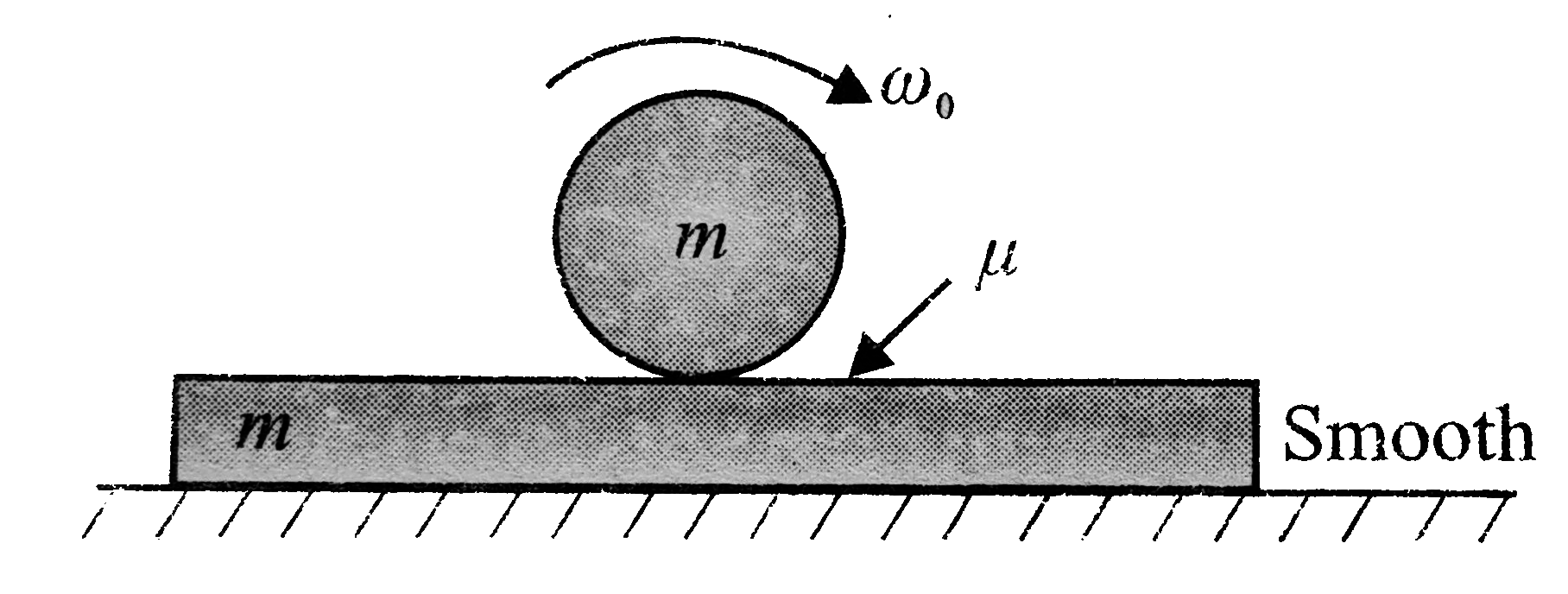
Find the time `t` at which the pure roiling starts05:37View SolutionA long horizontal plank of mass `m` is lying on a smooth horizontal surface. A sphere of same mass `m` and radius `r` is spinned about its own axis with angular velocity `omega_0` and gently placed on the plank. The coefficient of friction between the plank and the sphere is `mu`. After some time the pure rolling of the sphere on the plank will start. Answer the following questions.

Find the time `t` at which the pure roiling starts05:37View SolutionA long horizontal plank of mass `m` is lying on a smooth horizontal surface. A sphere of same mass `m` and radius `r` is spinned about its own axis with angular velocity we and gently placed on the plank. The coefficient of friction between the plank and the sphere is `mu`. After some time the pure rolling of the sphere on the plank will start. Answer the following questions.

Find the displacement of the plank till the sphere starts pure rolling.03:40View SolutionA disc of mass `m` and radius `R` is free to rotate in a horizontal plane about a vertical smooth fixed axis passing through its centre. There is a smooth groove along the diameter of the disc and two small balls of mass `m//2` each are placed in it on either side of the centre of the disc as shown in Fig. The disc is given an initial angular velocity `omega_(0)` and released.

The angular speed of the disc when the balls reach the end of the disc is01:54View SolutionA disc of mass `m` and radius `R` is free to rotate in a horizontal plane about a vertical smooth fixed axis passing through its centre. There is a smooth groove along the diameter of the disc and two small balls of mass `m//2` each are placed in it on either side of the centre of the disc as shown in Fig. The disc is given an initial angular velocity `omega_(0)` and released.
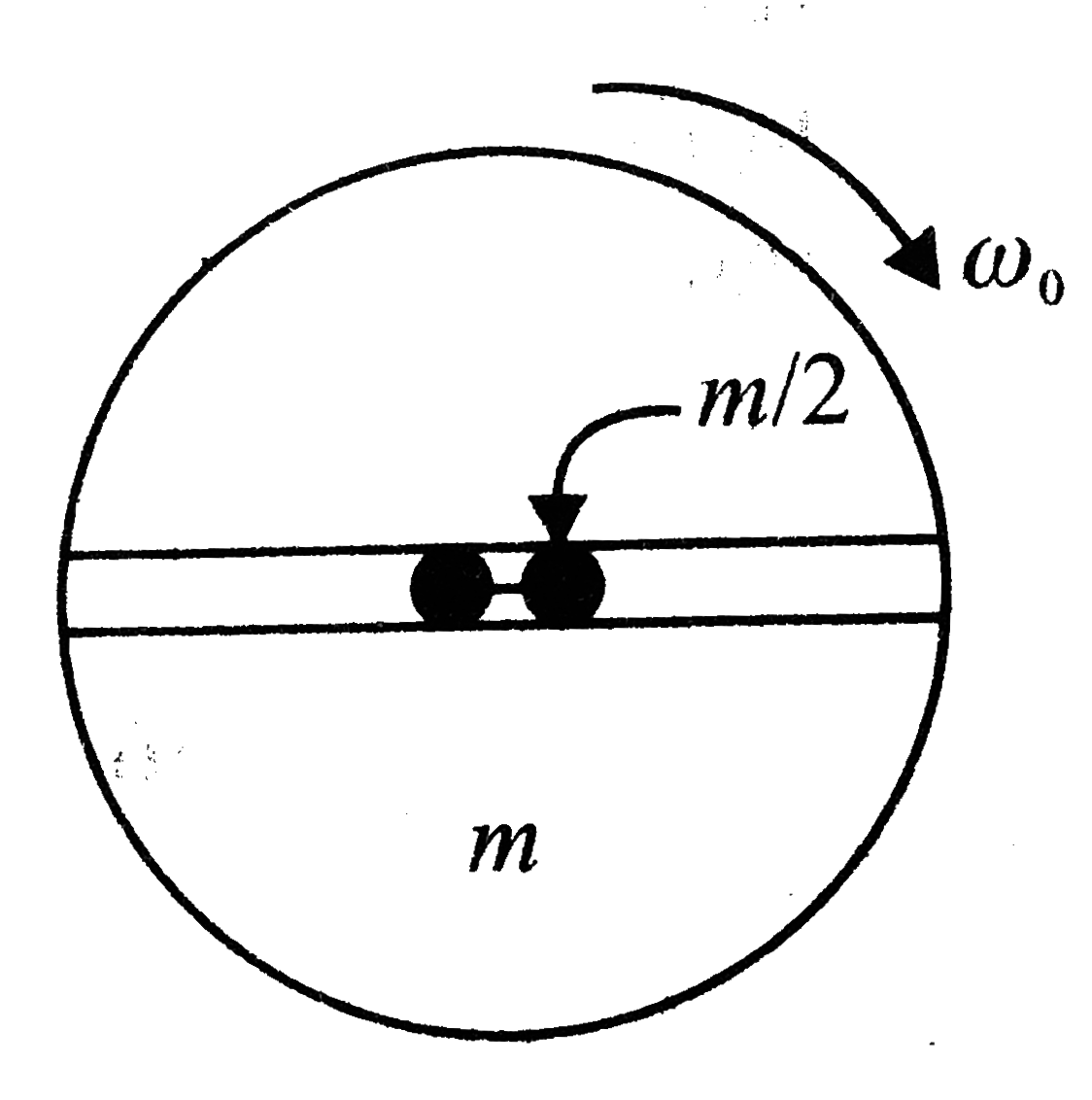
The speed of each ball relative to the ground just after they leave the disc is
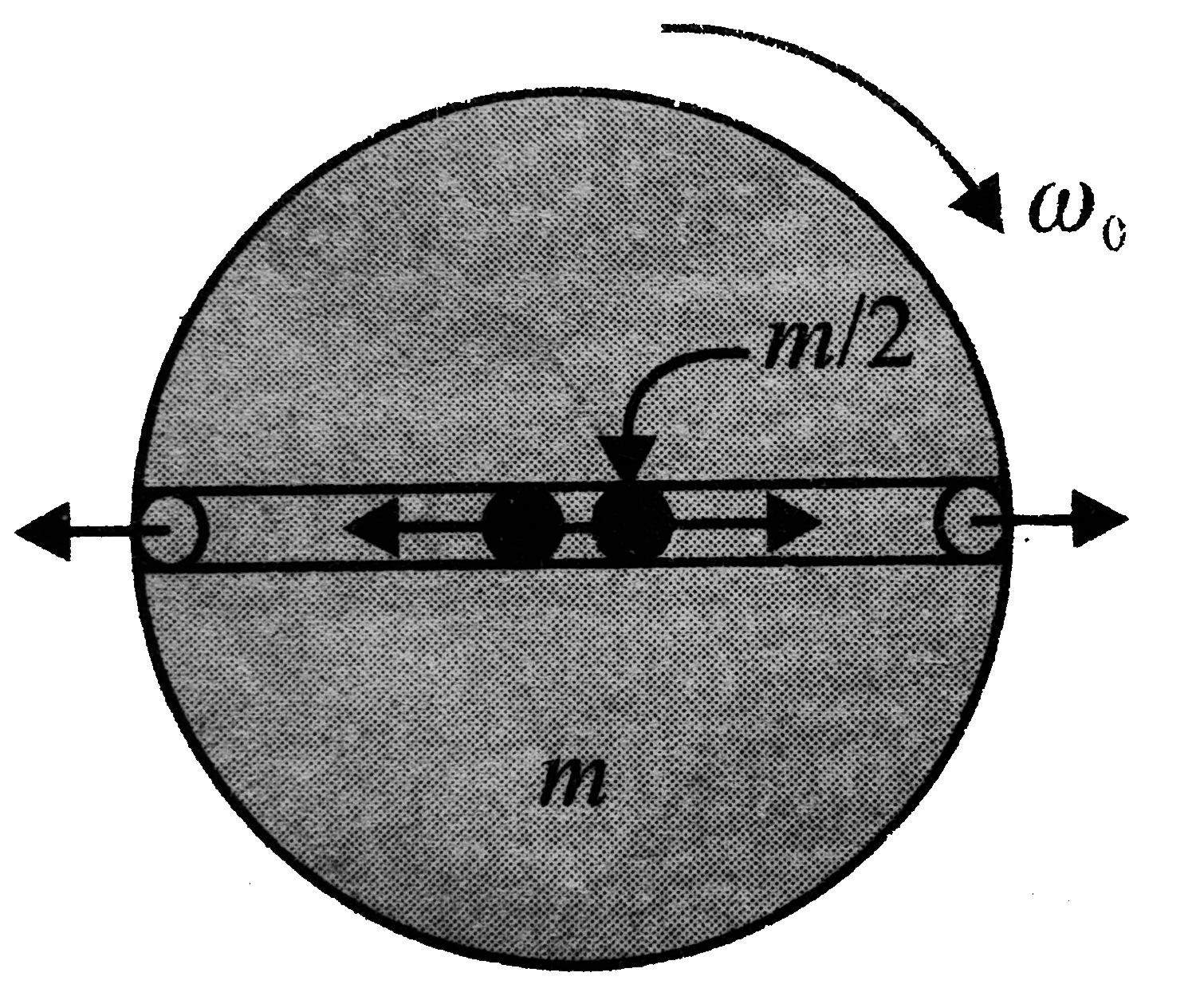 02:06View Solution
02:06View SolutionA disc of mass `m` and radius `R` is free to rotate in a horizontal plane about a vertical smooth fixed axis passing through its centre. There is a smooth groove along the diameter of the disc and two small balls of mass `m//2` each are placed in it on either side of the centre of the disc as shown in Fig. The disc is given an initial angular velocity `omega_(0)` and released.

The angular speed of the disc when the balls reach the end of the disc is01:54View SolutionA uniform rod of length `L` lies on a smooth horizontal table. The rod has a mass `M`. A particle of mass `m` moving with speed `v` strikes the rod perpendicularly at one of the ends of the rod sticks to it after collision.
Find the velocity of the centre of mass `C` and the angular, velocity of the system about the centre of mass after the collision.11:33View SolutionA uniform rod of length `L` lies on a smooth horizontal table. The rod has a mass `M`. A particle of mass `m` moving with speed `v` strikes the rod perpendicularly at one of the ends of the rod sticks to it after collision.
Find the velocity of the particle with respect to `C` before the collision02:38View SolutionA uniform rod of length `L` lies on a smooth horizontal table. The rod has a mass `M`. A particle of mass `m` moving with speed `v` strikes the rod perpendicularly at one of the ends of the rod sticks to it after collision.
Find the velocity of the particle with respect to `C` before the collision02:38View SolutionA uniform rod of mass M and length `a` lies on a smooth horizontal plane. A particle of mass m moving at a speed v perpendicular to the length of the rod strikes it at a distance `a/4` from the centre and stops after the collision. Find (a). the velocity of the centre of the rod and (b). the angular velocity of the rod abut its centre just after the collision.
05:26View SolutionA uniform rod of mass M and length `a` lies on a smooth horizontal plane. A particle of mass m moving at a speed v perpendicular to the length of the rod strikes it at a distance `a/4` from the centre and stops after the collision. Find (a). the velocity of the centre of the rod and (b). the angular velocity of the rod abut its centre just after the collision.
05:26View SolutionA uniform solid cylinder of mass `2 kg` and radius `0.2 m` is released from rest at the top of a semicircular track of radius `0.7 m` cut in a block of mass `M = 3 kg` as shown in Fig. The block is resting on a smooth horizontal surface and the cylinder rolls down without slipping. Based on the above information, answer the following questions:
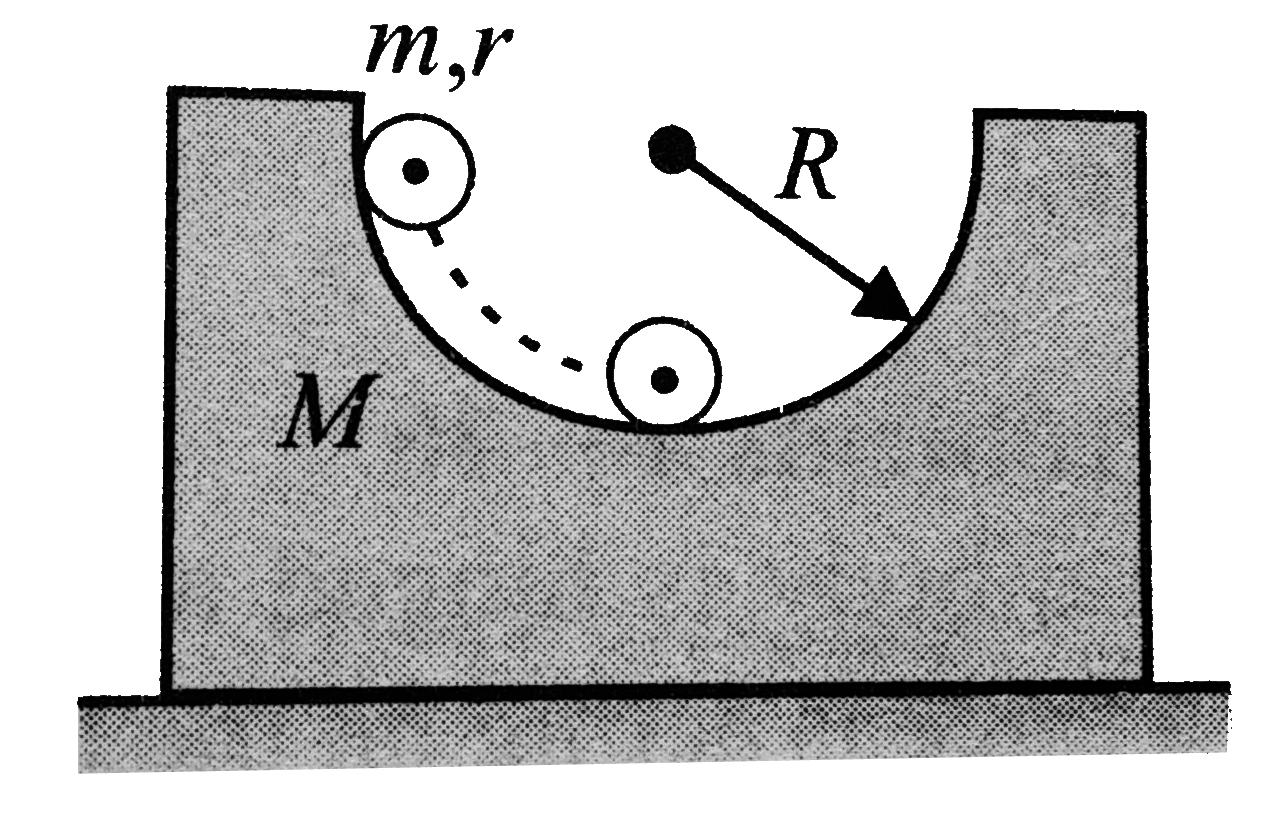
The distance moved by the block when the cylinder reaches the bottom of the track is04:04View SolutionA uniform solid cylinder of mass `2 kg` and radius `0.2 m` is released from rest at the top of a semicircular track of radius `0.7 m` cut in a block of mass `M = 3 kg` as shown in Fig. The block is resting on a smooth horizontal surface and the cylinder rolls down without slipping. Based on the above information, answer the following questions:

The distance moved by the block when the cylinder reaches the bottom of the track is04:04View SolutionA uniform solid cylinder of mass `2 kg` and radius `0.2 m` is released from rest at the top of a semicircular track of radius `0.7 m` cut in a block of mass `M = 3 kg` as shown in Fig. The block is resting on a smooth horizontal surface and the cylinder rolls down without slipping. Based on the above information, answer the following questions:

The speed of the point of contact of the cylinder with the block w.r.t. ground, when the cylinder reaches the bottom of the track is06:16View SolutionA disc of a mass `M` and radius `R` can rotate freely in vertical plane about a horizontal axis at `O`. Distant `r` from the center of disc as shown in the figure. The disc is released from rest in the shown position.
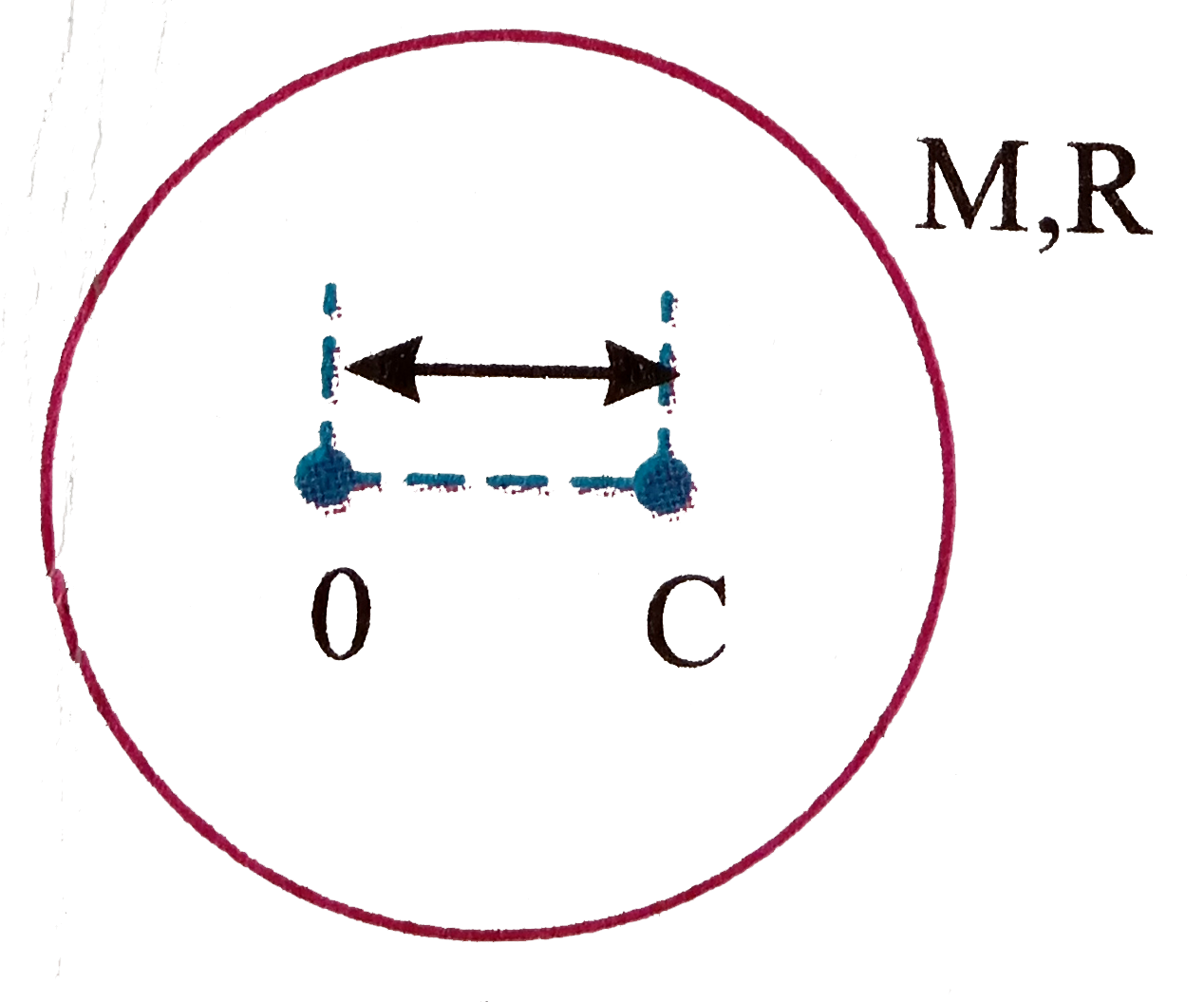
The angular acceleration of disc when `OC` rotates by an angles of `37^(@)` is03:13View SolutionTwo uniform spheres A (Hollow) and B (solid) of same radius R (
02:08View SolutionTwo uniform spheres A (Hollow) and B (solid) of same radius R (
02:08View SolutionIn the given figure F=10N , R=1 m , mass of the body is 2 kg and moment of inertia of the body about an axis passing through O and perpendicular to plane of body is `4 kg-m^(2)` .O is the centre of mass of the body.
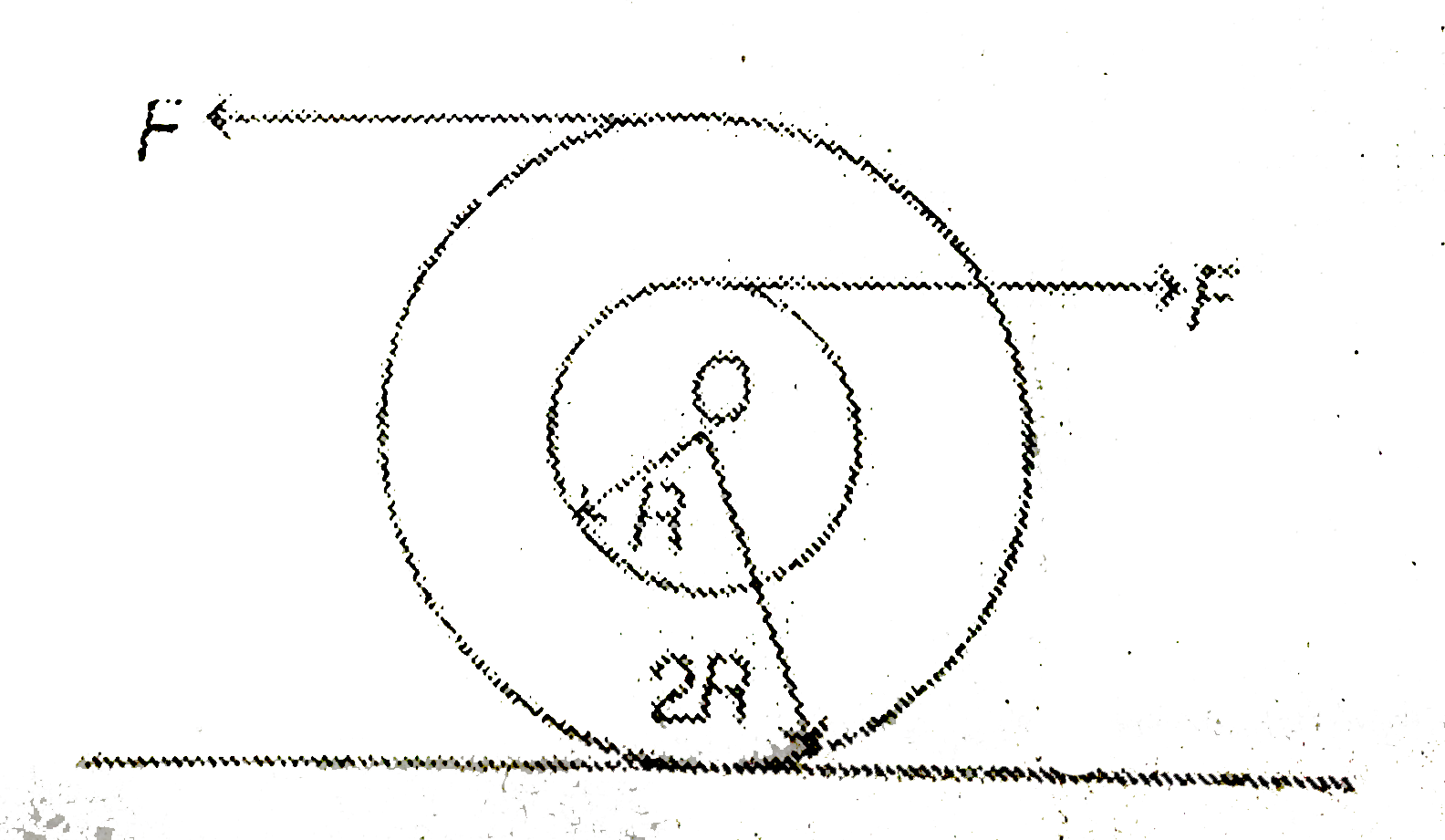
If the ground is smooth , what is total kinetic energy of the body after 2 s?02:50View SolutionIn the given figure F=10N , R=1 m , mass of the body is 2 kg and moment of inertia of the body about an axis passing through O and perpendicular to plane of body is `4 kg-m^(2)` .O is the centre of mass of the body.
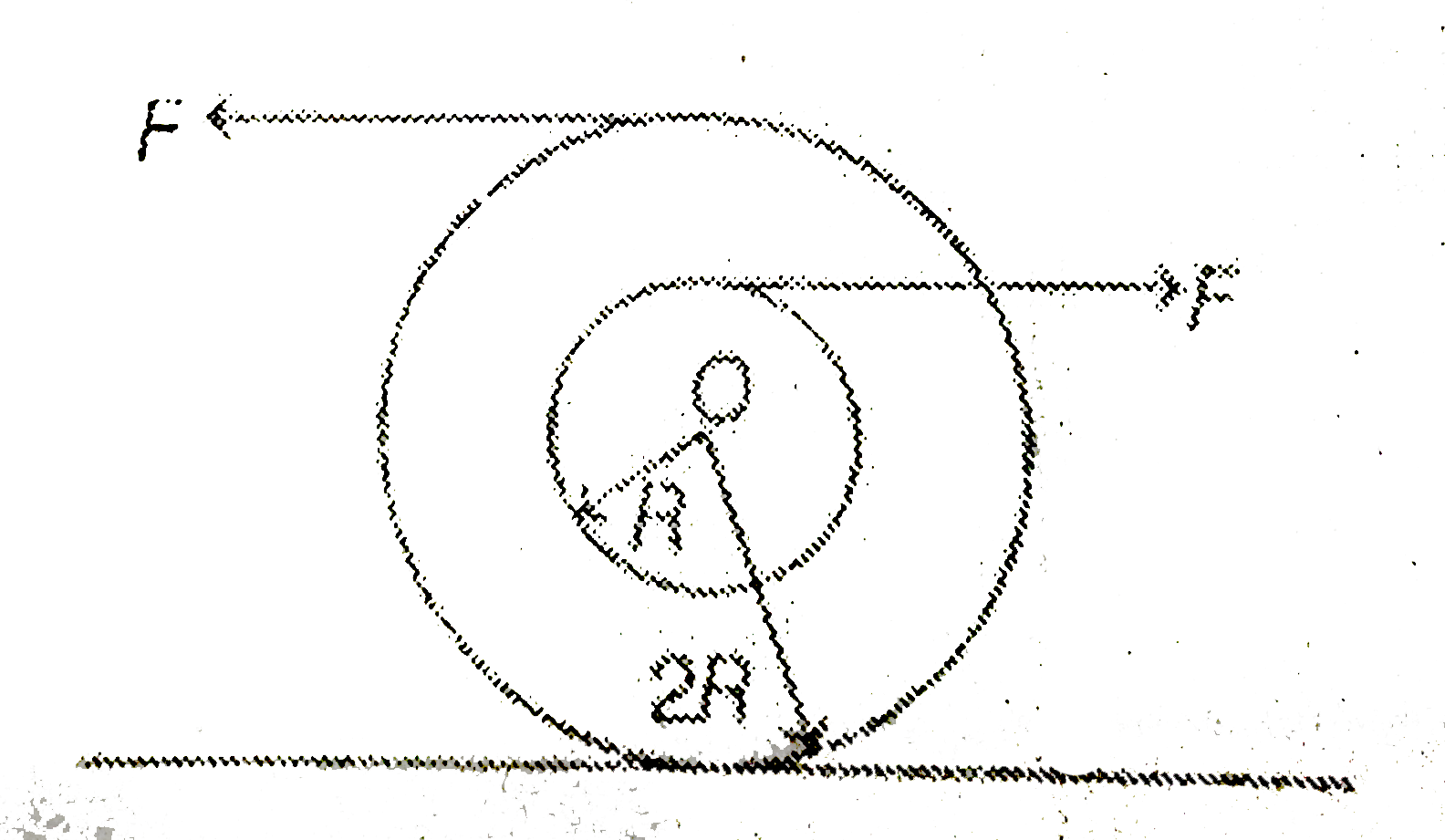
If ground is sufficiently rough , what is kinetic energy of the body now in the given time interval ?04:57View SolutionA disc of radius `20 CM` is rolling with slipping on a flat horizontal surface. At a certain instant the velocity of its centre is `4 m//s` and its angular velocity is `10 rad//s`. The lowest contact point is `O`.

Velocity of point `O` is01:35View SolutionA disc of radius `0.2 m` is rolling with slipping on a flat horizontal surface, as shown in Fig. The instantaneous centre of rotation is (the lowest contact point is `O` and centre of disc is `C`)
 02:51View Solution
02:51View SolutionA disc of radius `20 CM` is rolling without slipping on a flat horizontal surface. At a certain instant the velocity of its centre is `4 m//s` and its angular velocity is `10 rad//s`. The lowest contact point is `O`.
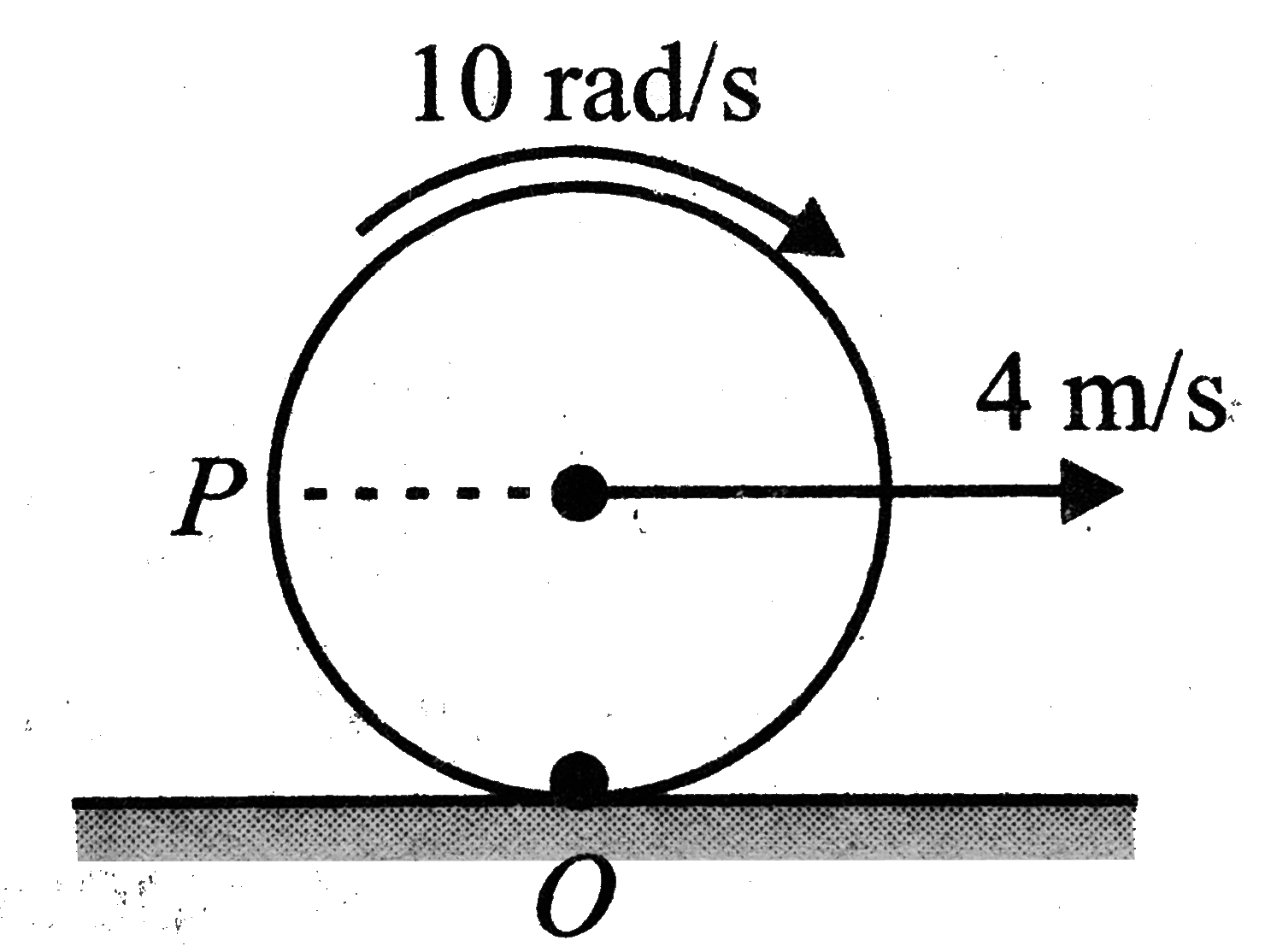
Velocity of point `P` is02:23View SolutionA solid sphere of mass `M` and radius `R` is initially at rest. Solid sphere is gradually lowered onto a truck moving with constant velocity `v_(0)`

What is the final speed of the sphere's centre of mass m ground frame when eventually pure rolling sets in08:28View SolutionA solid sphere of mass `M` and radius `R` is initially at rest. Solid sphere is gradually lowered onto a truck moving with constant velocity `v_(0)`

What is the final speed of the sphere's centre of mass m ground frame when eventually pure rolling sets in08:28View SolutionA uniform rod `AB` hinged about a fixed point `P` is initially vertical. A rod is released from vertical position. When rod is in horizontal position:

The acceleration of the centre of mass of the rod is05:45View SolutionA uniform rod `AB` hinged about a fixed point `P` is initially vertical. A rod is released from vertical position. When rod is in horizontal position:

The acceleration of end `B` of the rod is03:41View SolutionA uniform rod `AB` hinged about a fixed point `P` is initially vertical. The rod is released from vertical position. When rod is in horizontal position:

The acceleration of the centre of mass of the rod is05:45View SolutionA uniform disc of mass `m` and radius `R` rotates about a fixed vertical axis passing through its centre with angular velocity `omega`. A particle of same mass `m` and having velocity of `2omegaR` towards centre of the disc collides with the disc moving horizontally and sticks to its rim. Then
05:22View SolutionA uniform disc of mass `m` and radius `R` rotates about a fixed vertical axis passing through its centre with angular velocity `omega`. A particle of same mass `m` and having velocity of `2omegaR` towards centre of the disc collides with the disc moving horizontally and sticks to its rim. Then
05:22View SolutionWhen a body is hinged at a point and a force is acting on the body in such a way that the line of action of force is at some distance from the hinged point, the body will start rotating about the hinged point. The angular acceleration of the body can be calculated by finding the torque of that force about the hinged point. A disc of mass `m` and radius `R` is hinged at point `A` at its bottom and is free to rotate in the vertical plane. A force of magnitude `F` is acting on the ring at top most point.
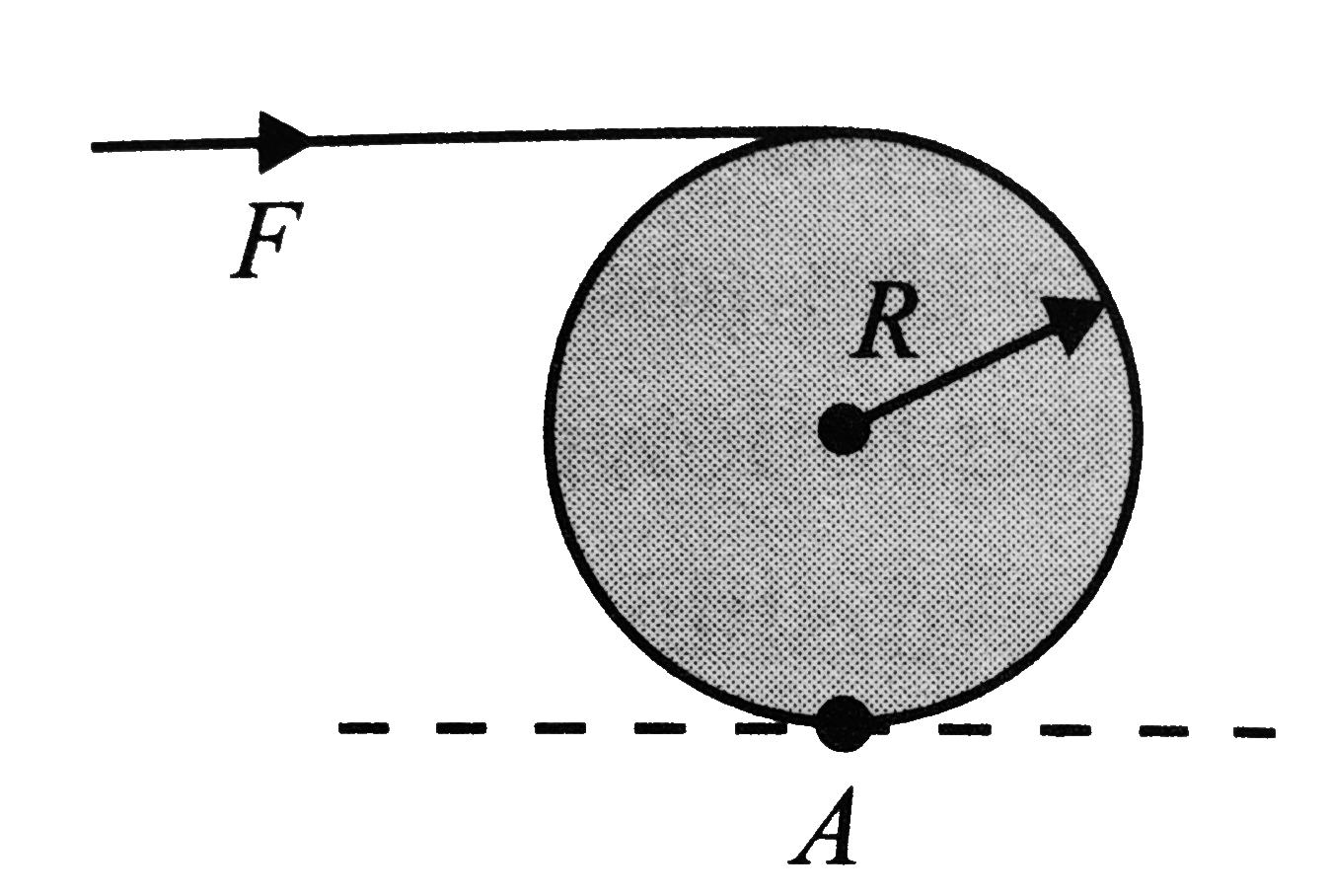
Tangential acceleration of the centre of mass is03:32View SolutionWhen a body is hinged at a point and a force is acting on the body in such a way that the line of action of force is at some distance from the hinged point, the body will start rotating about the hinged point. The angular acceleration of the body can be calculated by finding the torque of that force about the hinged point. A disc of mass `m` and radius `R` is hinged at point `A` at its bottom and is free to rotate in the vertical plane. A force of magnitude `F` is acting on the ring at top most point.
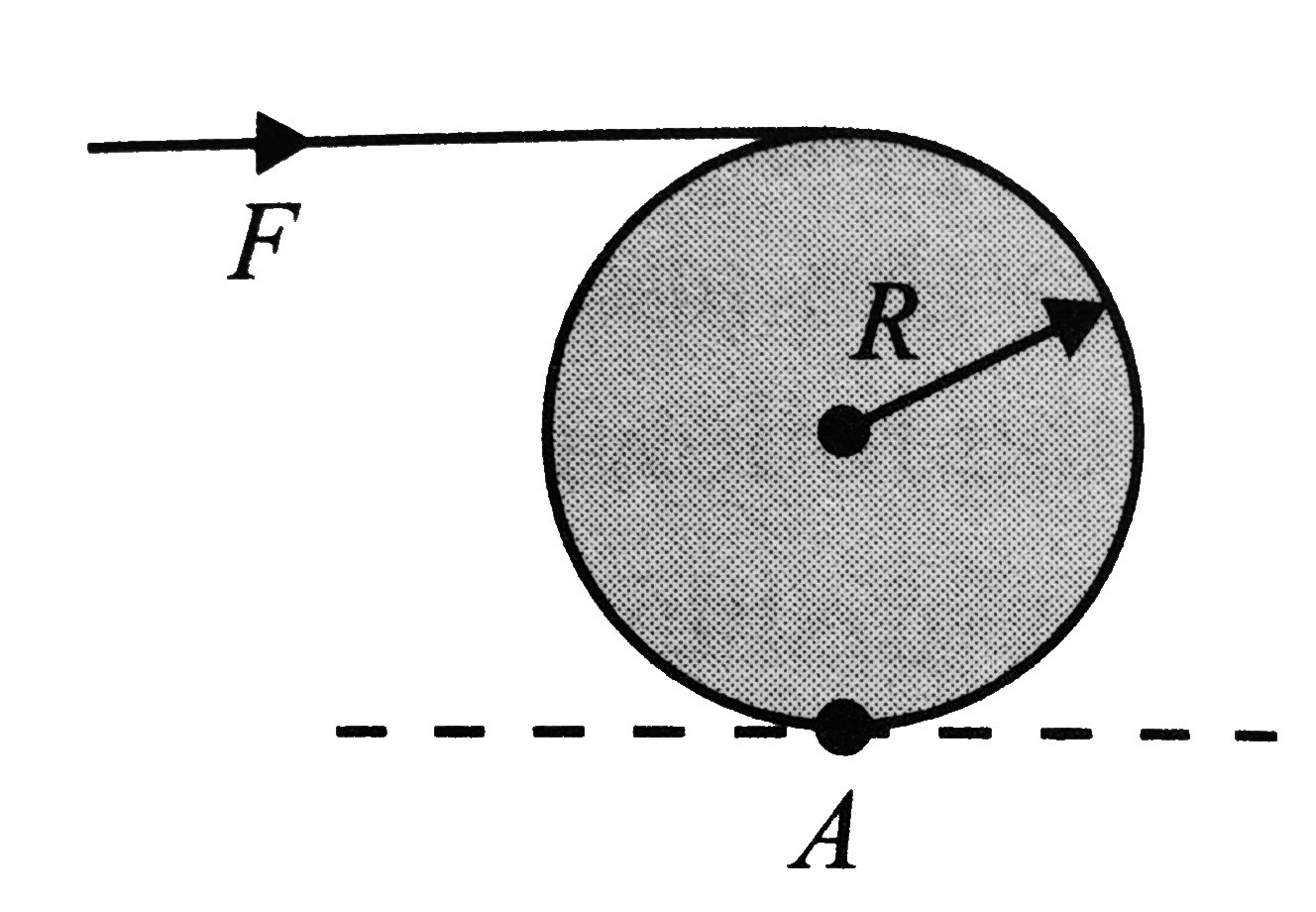
Component of reaction at the hinge in the vertical direction is02:36View SolutionWhen a body is hinged at a point and a force is acting on the body in such a way that the line of action of force is at some distance from the hinged point, the body will start rotating about the hinged point. The angular acceleration of the body can be calculated by finding the torque of that force about the hinged point. A disc of mass `m` and radius `R` is hinged at point `A` at its bottom and is free to rotate in the vertical plane. A force of magnitude `F` is acting on the ring at top most point.
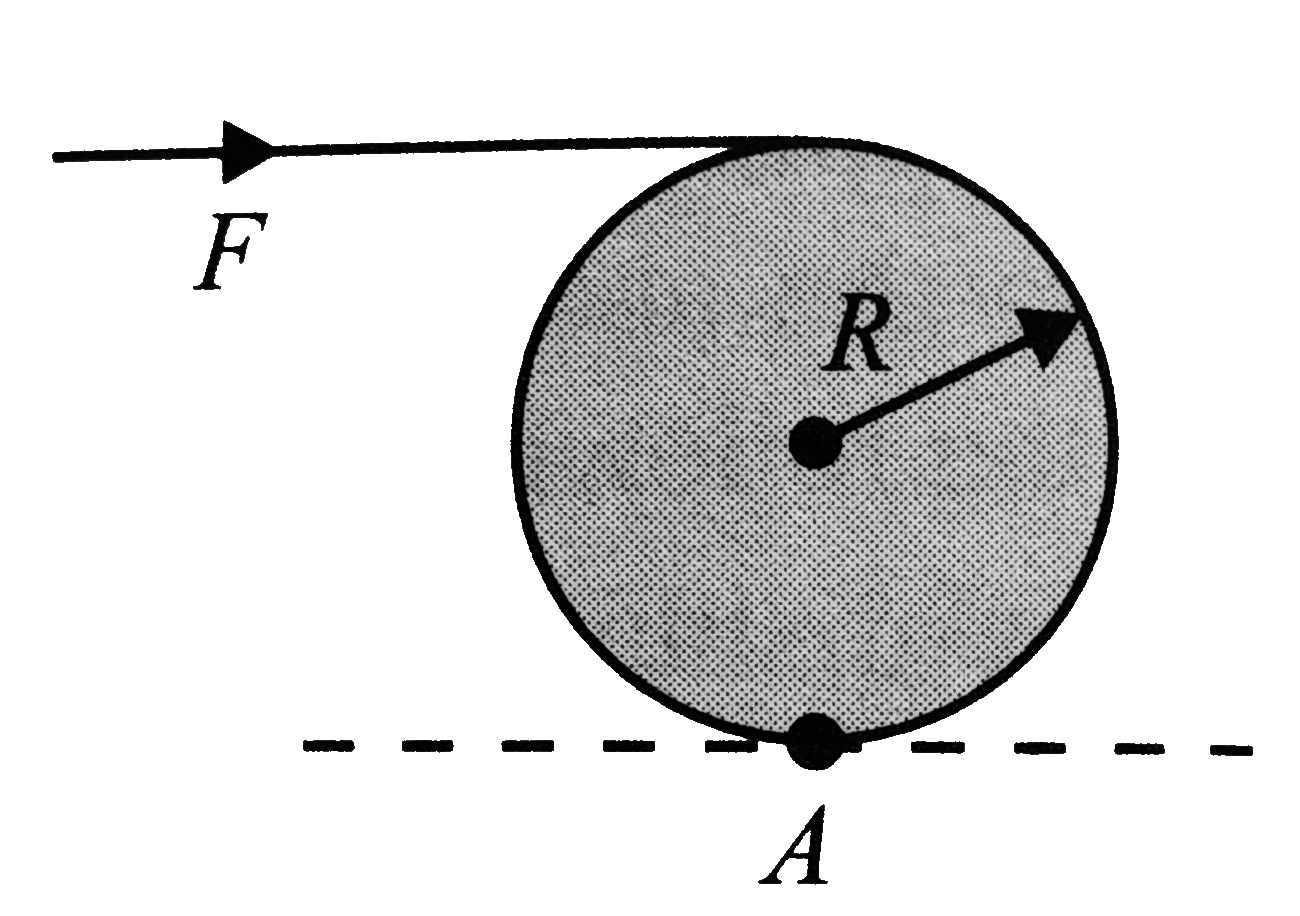
Component of reaction at the hinge in the horizontal direction is03:10View SolutionA rod `AB` of mass `M` and length `8l` lies on a smooth horizontal surface. A particle, of mass `m` and velocity `v_(0)` strike's the rod perpendicular to its length, as shown in Fig. As a result of the collision, the centre of mass of the rod attains a speed of `v_(0)//8` and the particle rebounds back with a speed of `v_(0)//4`. Find the following: a. The ratio `M//m`. b. The angular velocity of the rod about `O`. c. The coefficient of restitution `'e'` for the collision. d. The velocities of the ends `'A'` and `'B'` of the rod, namely, `v_(A)` and `v_(B)` respectively.
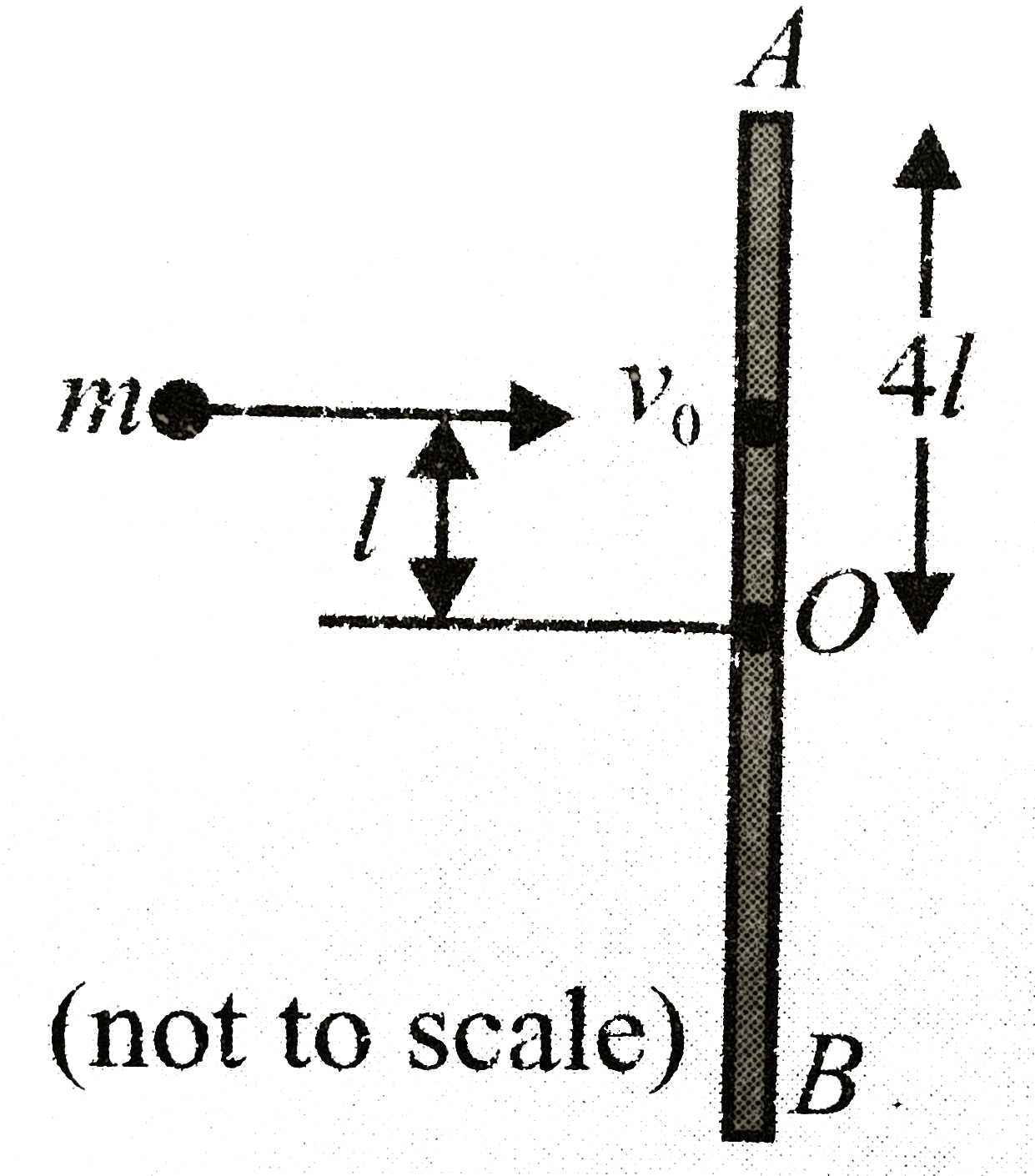 08:49View Solution
08:49View SolutionA rod `AB` of mass `M` and length `8l` lies on a smooth horizontal surface. A particle, of mass `m` and velocity `v_(0)` strike's the rod perpendicular to its length, as shown in Fig. As a result of the collision, the centre of mass of the rod attains a speed of `v_(0)//8` and the particle rebounds back with a speed of `v_(0)//4`. Find the following: a. The ratio `M//m`. b. The angular velocity of the rod about `O`. c. The coefficient of restitution `'e'` for the collision. d. The velocities of the ends `'A'` and `'B'` of the rod, namely, `v_(A)` and `v_(B)` respectively.
 08:49View Solution
08:49View SolutionA rod `AB` of mass `M` and length `8l` lies on a smooth horizontal surface. A particle, of mass `m` and velocity `v_(0)` strike's the rod perpendicular to its length, as shown in Fig. As a result of the collision, the centre of mass of the rod attains a speed of `v_(0)//8` and the particle rebounds back with a speed of `v_(0)//4`. Find the following: a. The ratio `M//m`. b. The angular velocity of the rod about `O`. c. The coefficient of restitution `'e'` for the collision. d. The velocities of the ends `'A'` and `'B'` of the rod, namely, `v_(A)` and `v_(B)` respectively.
 08:49View Solution
08:49View SolutionA rod `AB` of mass `M` and length `8l` lies on a smooth horizontal surface. A particle, of mass `m` and velocity `v_(0)` strike's the rod perpendicular to its length, as shown in Fig. As a result of the collision, the centre of mass of the rod attains a speed of `v_(0)//8` and the particle rebounds back with a speed of `v_(0)//4`. Find the following: a. The ratio `M//m`. b. The angular velocity of the rod about `O`. c. The coefficient of restitution `'e'` for the collision. d. The velocities of the ends `'A'` and `'B'` of the rod, namely, `v_(A)` and `v_(B)` respectively.
 08:49View Solution
08:49View SolutionA Iong slender rod of mass `2 kg` and length `m` is placed on a smooth horizontal table. Two particles of masses `2 kg` and ` 1kg` strike the rod simultaneously and stick to the rod after collision as shown in fig.
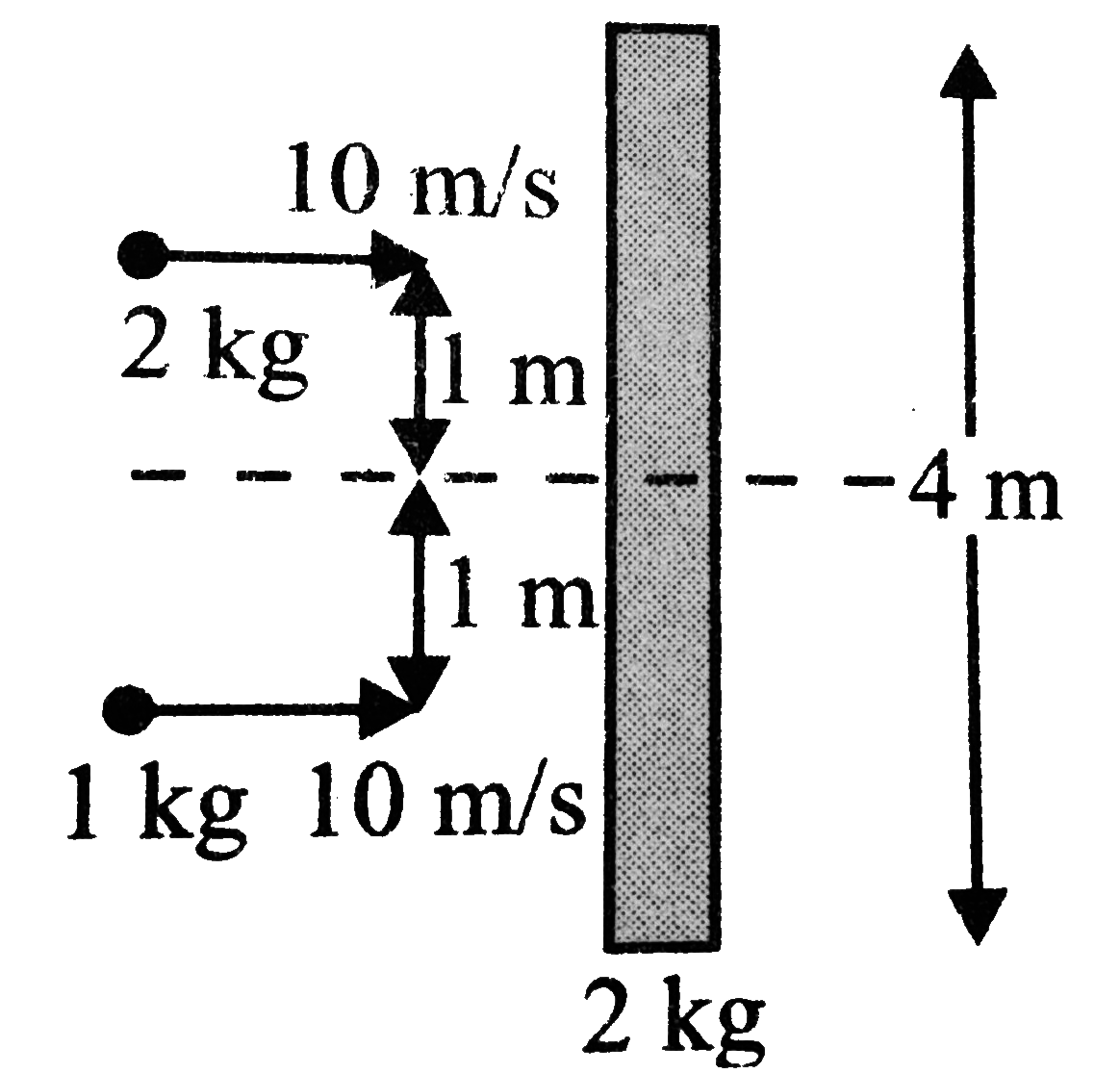
Velocity of the centre of mass of the rod after collision is02:38View SolutionA Iong slender rod of mass `2 kg` and length `m` is placed on a smooth horizontal table. Two particles of masses `2 kg` and ` 1kg` strike the rod simultaneously and stick to the rod after collision as shown in fig.

Angular velocity of the rod after collision is03:56View SolutionA Iong slender rod of mass `2 kg` and length `m` is placed on a smooth horizontal table. Two particles of masses `2 kg` and ` 1kg` strike the rod simultaneously and stick to the rod after collision as shown in fig.

Angular velocity of the rod after collision is03:56View SolutionA spherical ball of mass `M` moving with initial velocity `V` collides elastically with another ball of mass `M`, which is fixed at one end of `L` shaped rigid massless frame as shown in Fig. (a). The `L` shaped frame contains another mass `M` connected at the other end.
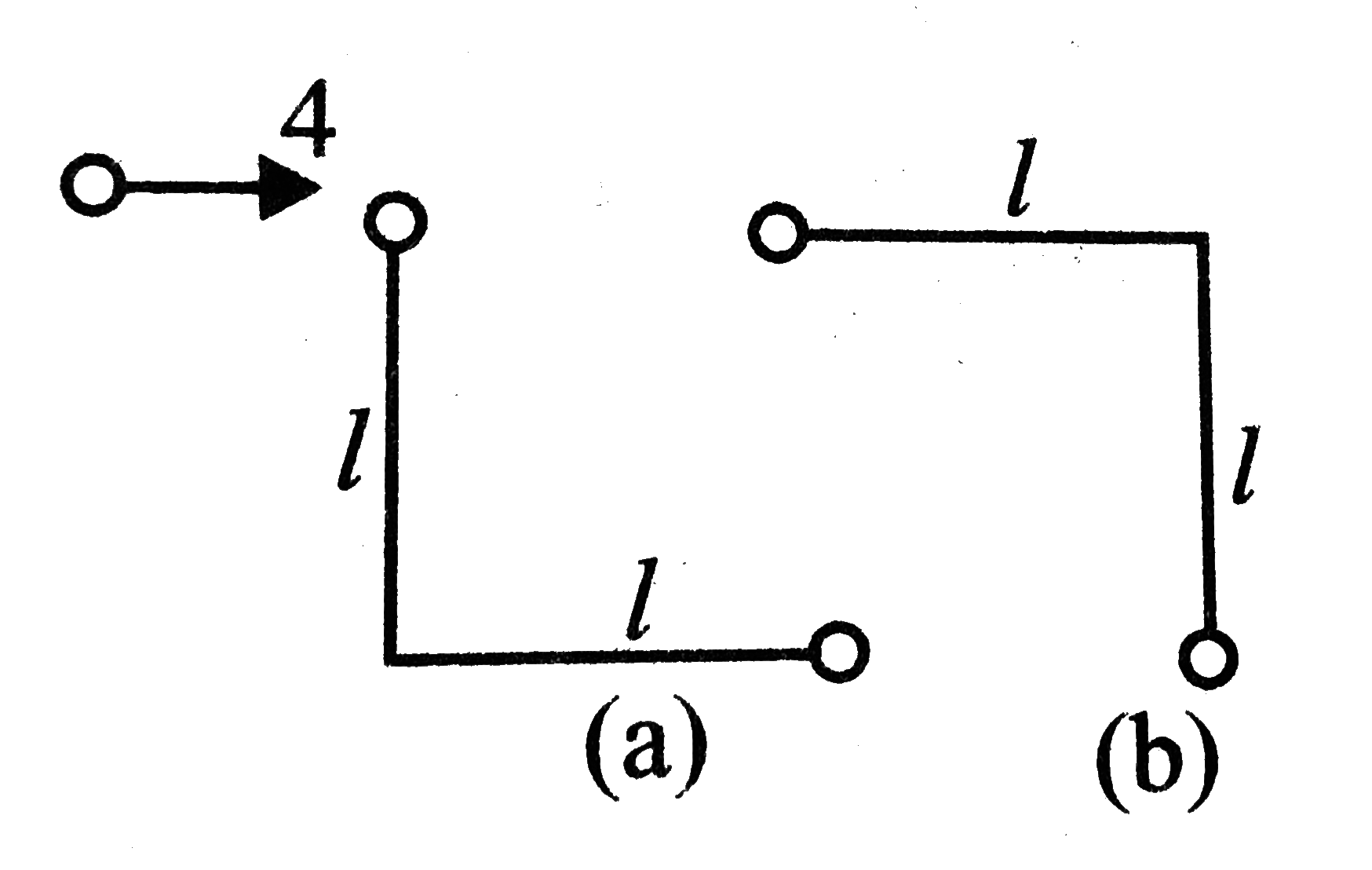
The speed of the striking mass after collision is04:51View SolutionA spherical ball of mass `M` moving with initial velocity `u` collides elastically with another ball of mass `M`, which is fixed at one end of `L` shaped rigid massless frame as shown in Fig. (a). The `L` shaped frame contains another mass `M` connected at the other end.

The speed of the striking mass after collision is04:51View SolutionA spherical ball of mass `M` moving with initial velocity `u` collides elastically with another ball of mass `M`, which is fixed at one end of `L` shaped rigid massless frame as shown in Fig. (a). The `L` shaped frame contains another mass `M` connected at the other end.

The speed of the striking mass after collision is04:51View SolutionA solid cylinder of mass `m` is kept in balance on a fixed incline of angle `alpha=37^@` with the help of a thread fastened to its jacket. The cylinder does not slip.

What force `F` is reqired to kep the cylinder in balance when the thread is held vertically?02:31View SolutionA solid cylinder of mass `m` is kept in balance on a fixed incline of angle `alpha=37^@` with the help of a thread fastened to its jacket. The cylinder does not slip.
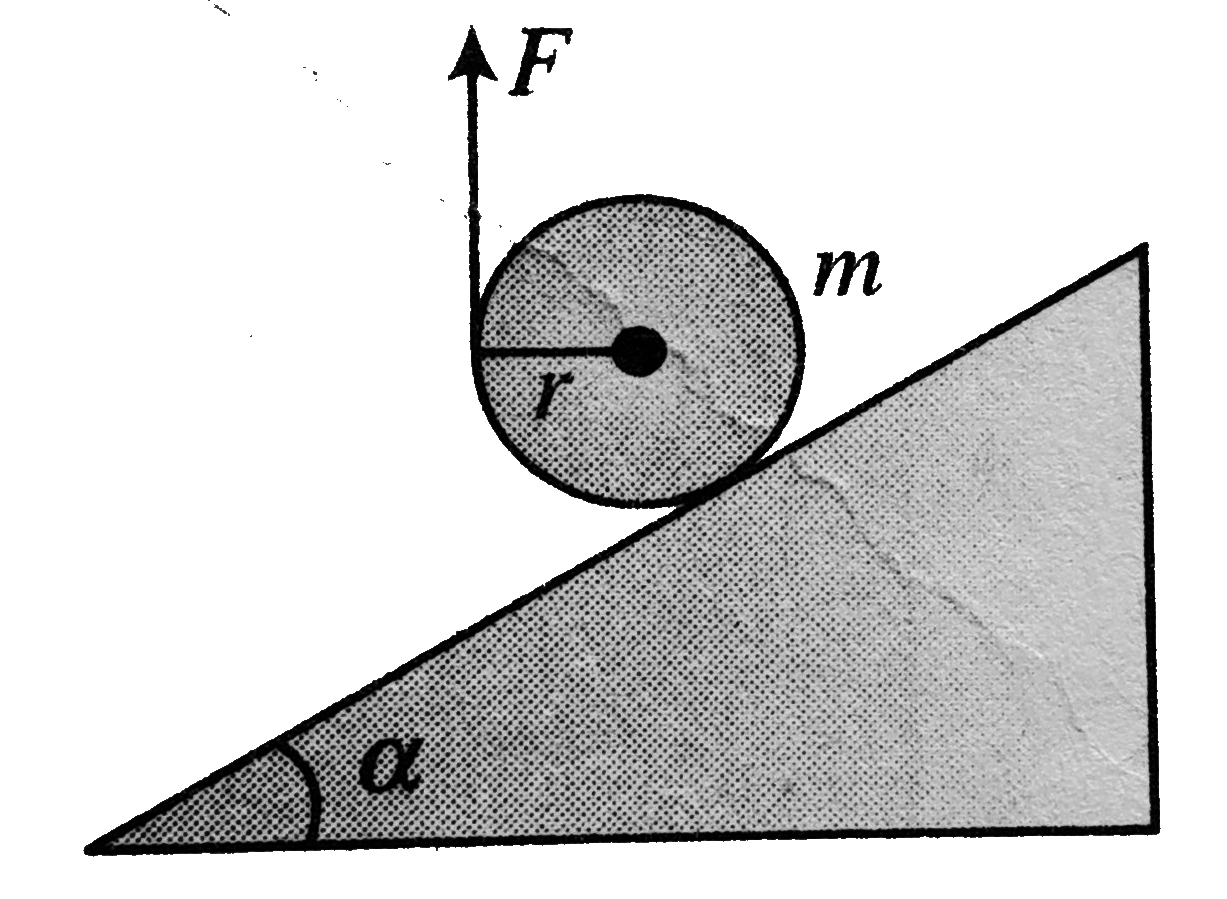
In what direction should the thread be pulled to minimise the force required to hold the cylinder? What is the magnitude of this force?03:34View SolutionA solid cylinder of mass `m` is kept in balance on a fixed incline of angle `alpha=37^@` with the help of a thread fastened to its jacket. The cylinder does not slip.
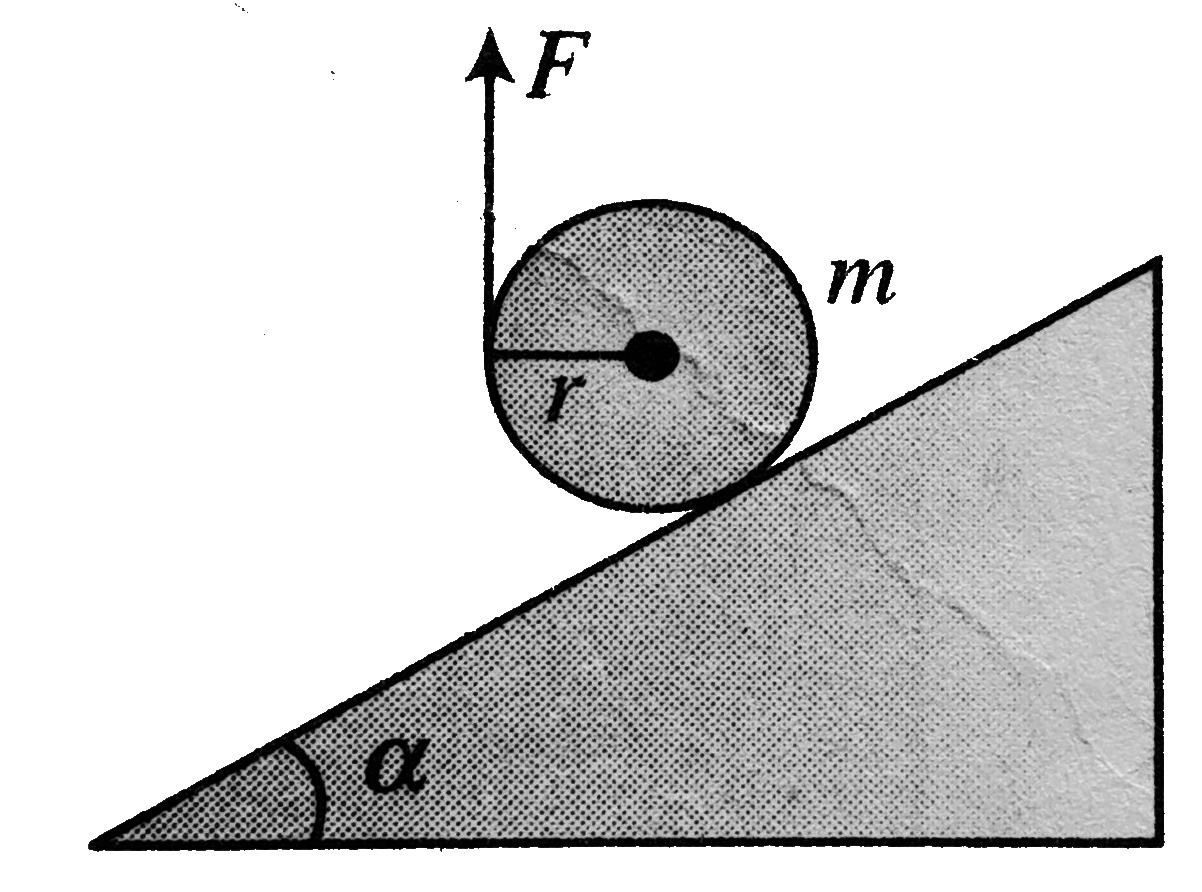
The values of minimum coefficient of static friction between cylinder and incline in the case when `F` is minimum.05:10View SolutionA ball, rolling purely on a horizontal floor with centre's speed `v`, hits a smooth vertical wall surface elastically. Answer the following questions.
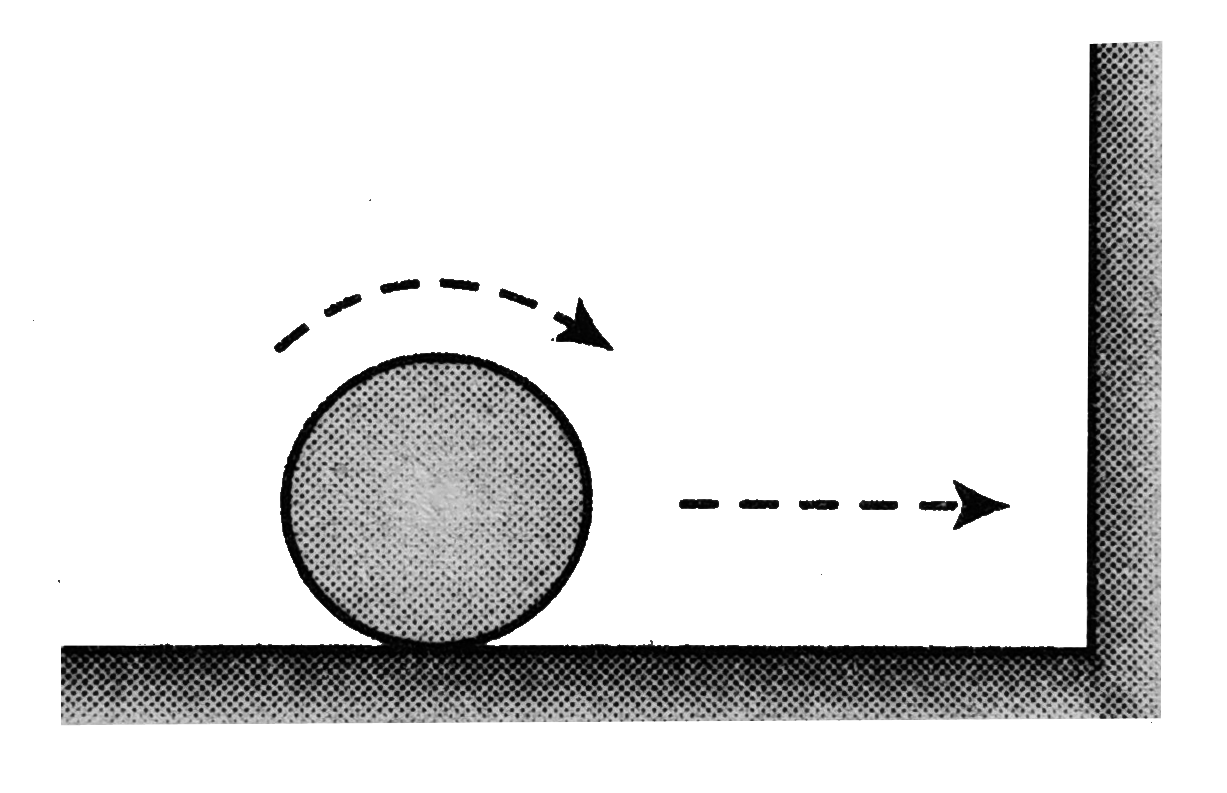
Just after the collision is over, the velocity of the lowest point of the ball is03:03View SolutionA ball, rolling purely on a horizontal floor with centre's speed `v`, hits a smooth vertical wall surface elastically. Answer the following questions.

The change in angular momentum of the solid ball (mass `m`, radius `R`), about the corner point of floor and wall, due to the collision is02:00View SolutionA uniform disc of mass `1 kg` and radius `20 cm` is rolling purely on a flat horizontal surface. Its centre `C` is moving with acceleration `a = 20 ms^(-2)` and velocity `v =4 m//s` at a certain instant. At this instant. points `A` and `B` are located on the disc as shown in the diagram, with `AC = BC = 10 cm`.
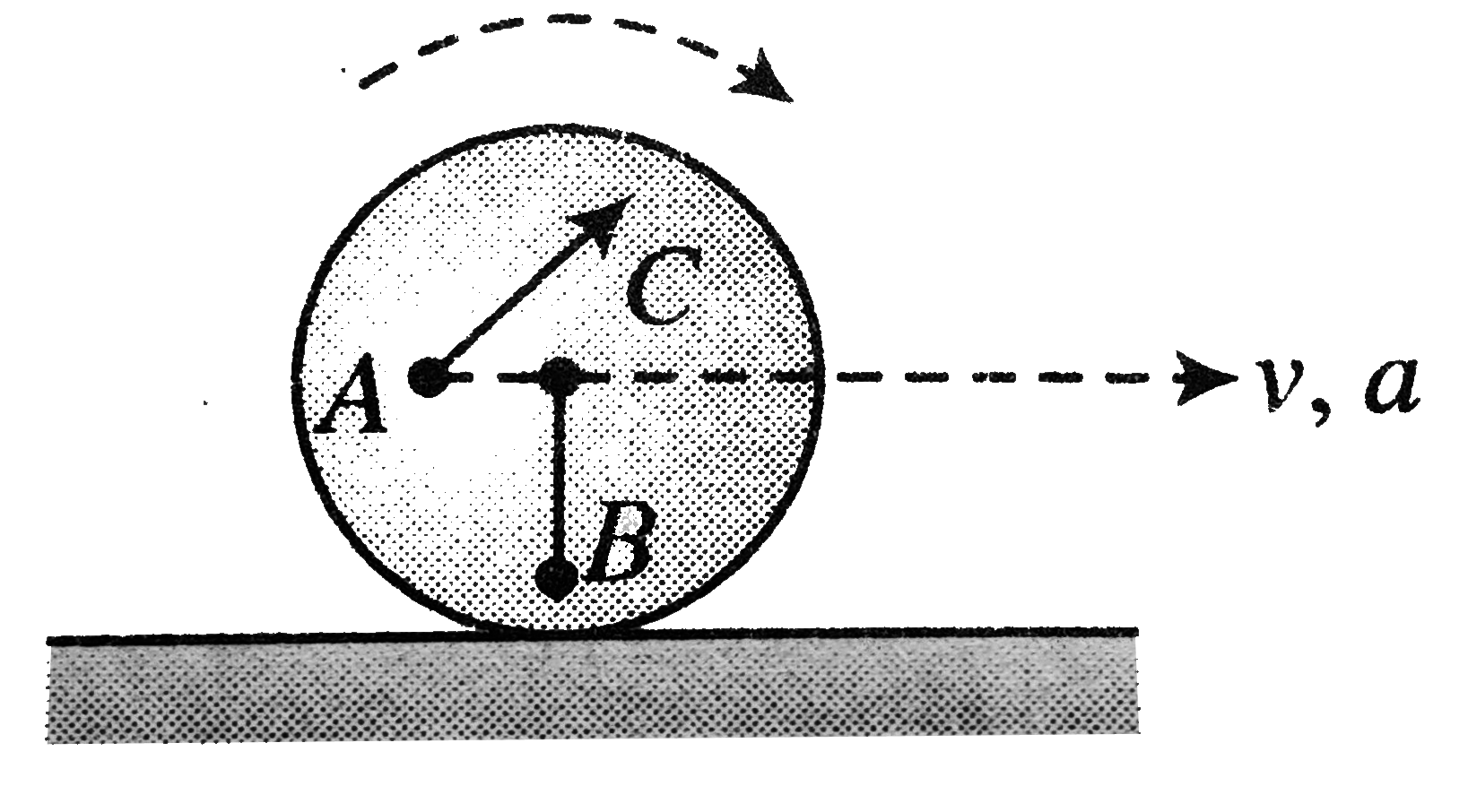
What is the kinetic energy of the disc?02:07View SolutionA uniform disc of mass `1 kg` and radius `20 cm` is rolling purely on a flat horizontal surface. Its centre `C` is moving with acceleration `a = 20 ms^(-2)` and velocity `v =4 m//s` at a certain instant. At this instant. points `A` and `B` are located on the disc as shown in the diagram, with `AC = BC = 10 cm`.
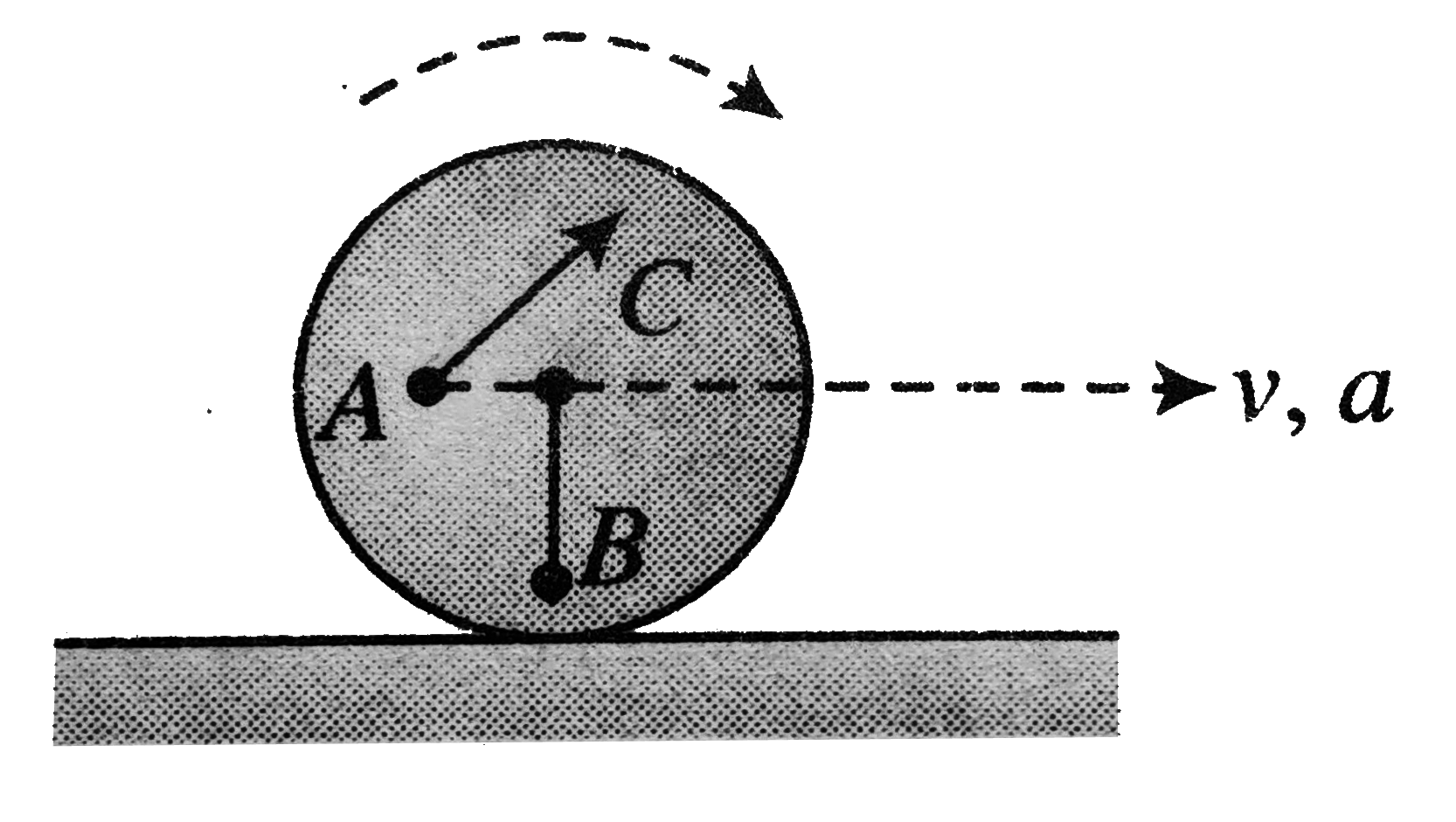
What is the acceleration magnitude of point `A`?06:43View SolutionA uniform disc of mass `1 kg` and radius `20 cm` is rolling purely on a flat horizontal surface. Its centre `C` is moving with acceleration `a = 20 ms^(-2)` and velocity `v =4 m//s` at a certain instant. At this instant. points `A` and `B` are located on the disc as shown in the diagram, with `AC = BC = 10 cm`.

What is the acceleration magnitude of point `B`?04:48View SolutionIn this passage a brief idea is given of the motion of the rolling bodies on an inclined plane. We will consider three cases: objects are released on an incline plane
Case-A: which is smooth.
Case-B: where friction is insufficient to provide pure rolling.
Case-C: where friction is sufficient to provide pure rolling. Force diagram for three cases are as follows: (where symbols have their usual meanings)
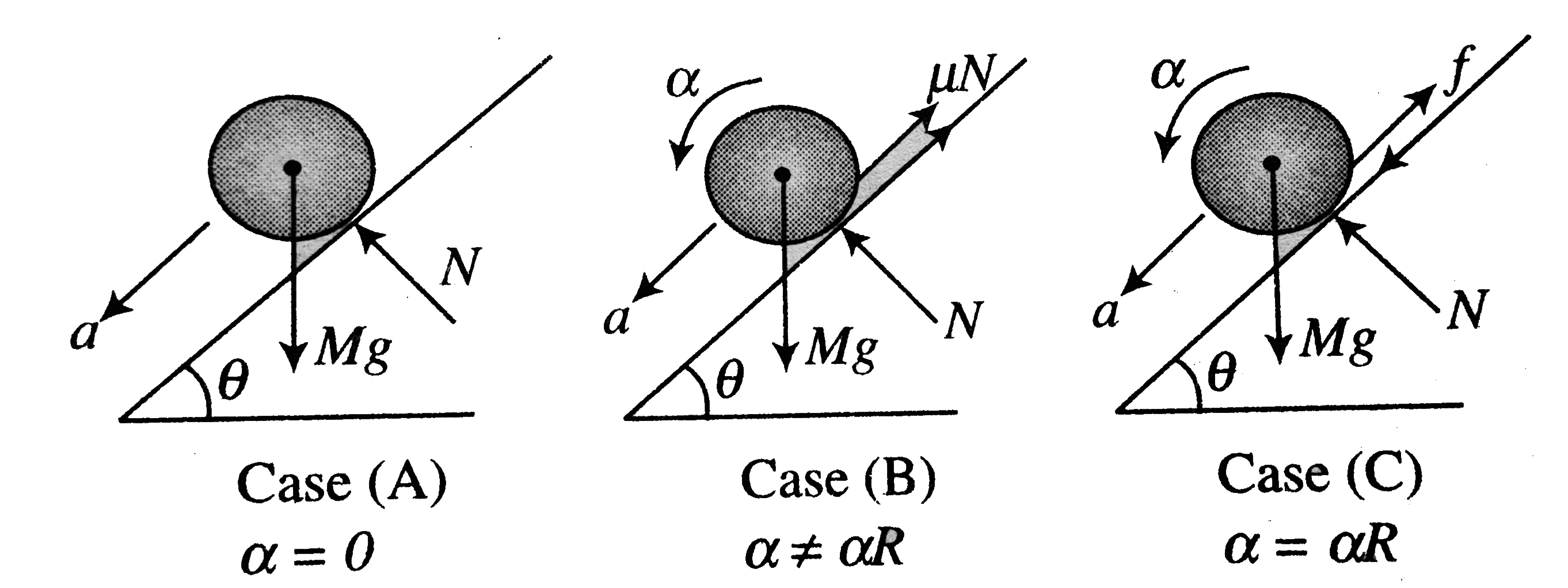
If the four objects given in the above question are of same mass, same radius having the same friction coefficient and are released from the same height, then at the bottom the object which will have least kinetic energy for case `B` will be the:04:23View SolutionIn this passage a brief idea is given of the motion of the rolling bodies on an inclined plane. We will consider three cases: objects are released on an incline plane
Case-A: which is smooth.
Case-B: where friction is insufficient to provide pure rolling.
Case-C: where friction is sufficient to provide pure rolling. Force diagram for three cases are as follows: (where symbols have their usual meanings)

If the four objects given in the above question are of same mass, same radius having the same friction coefficient and are released from the same height, then at the bottom the object which will have least kinetic energy for case `B` will be the:04:23View SolutionIn this passage a brief idea is given of the motion of the rolling bodies on an inclined plane. We will consider three cases: objects are released on an incline plane
Case-A: which is smooth.
Case-B: where friction is insufficient to provide pure rolling.
Case-C: where friction is sufficient to provide pure rolling. Force diagram for three cases are as follows: (where symbols have their usual meanings)

If the four objects given in the above question are of same mass, same radius having the same friction coefficient and are released from the same height, then at the bottom the object which will have least kinetic energy for case `B` will be the:04:23View SolutionIn this passage a brief idea is given of the motion of the rolling bodies on an inclined plane. We will consider three cases: objects are released on an incline plane
Case-A: which is smooth.
Case-B: where friction is insufficient to provide pure rolling.
Case-C: where friction is sufficient to provide pure rolling. Force diagram for three cases are as follows: (where symbols have their usual meanings)
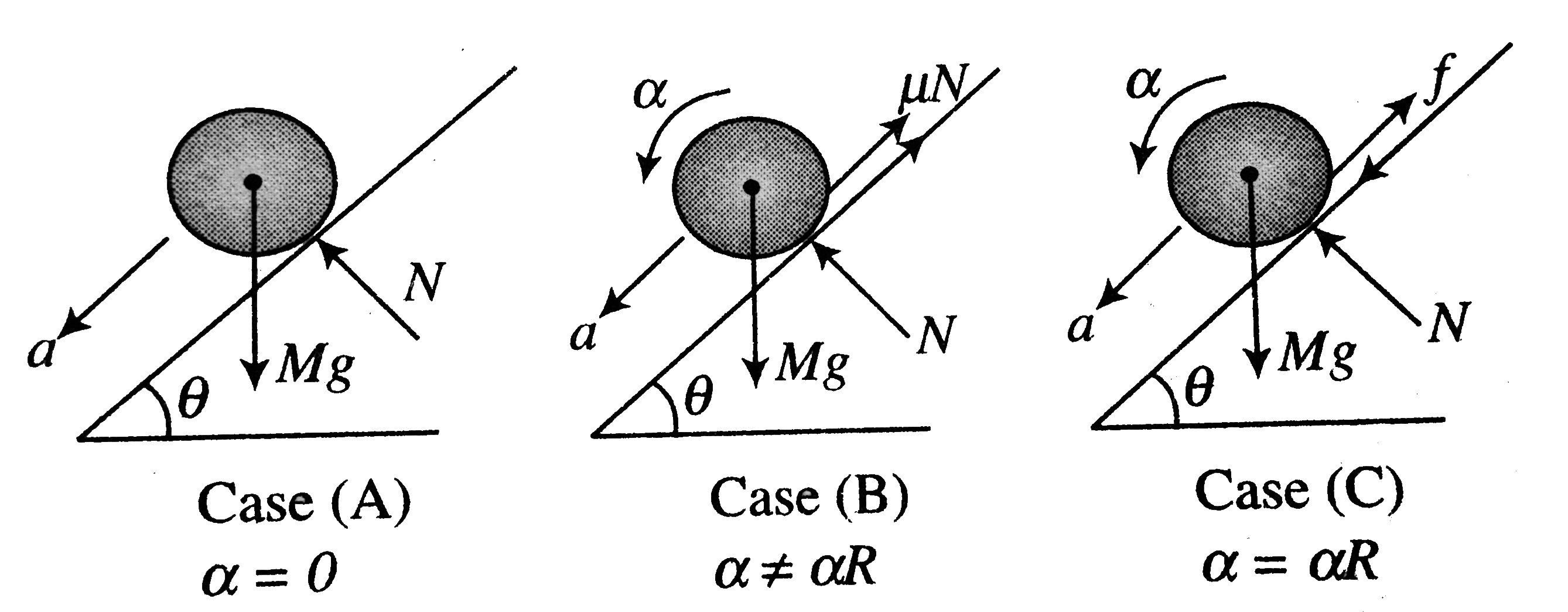
Two children `A` and `B` use bicycles, having wheels of ring type and disc type respectively. During a race, bicycles are given the same velocity from the bottom of the inclined bridge to ascend the bridge without pedalling, then (assuming pure rolling).03:22View SolutionA gardener presses the grasscutter with a force `F` at an angle `theta`. Assume the motion of grasscutter as pure rolling. Find the:

friction between the grasscutter (assumed as a disc) and ground.02:40View SolutionA gardener presses the grasscutter with a force `F` at an angle `theta`. Assume the motion of grasscutter as pure rolling. Find the:
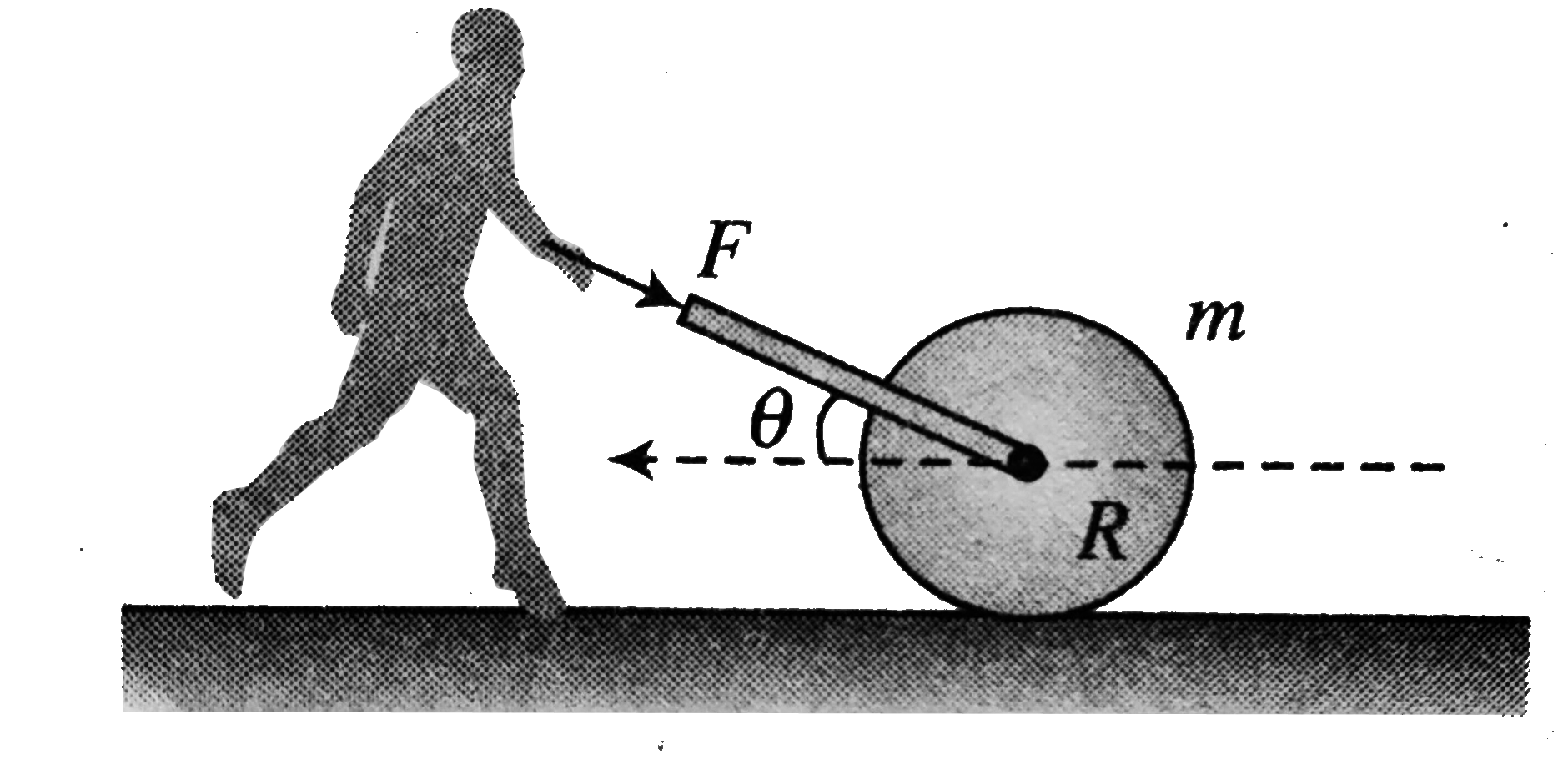
Acceleration of `CM` of the roller (disc). Assume that the mass of the disc is `m` and neglect the mass of the connecting rod.02:51View SolutionA gardener presses the grasscutter with a force `F` at an angle `theta`. Assume the motion of grasscutter as pure rolling. Find the:
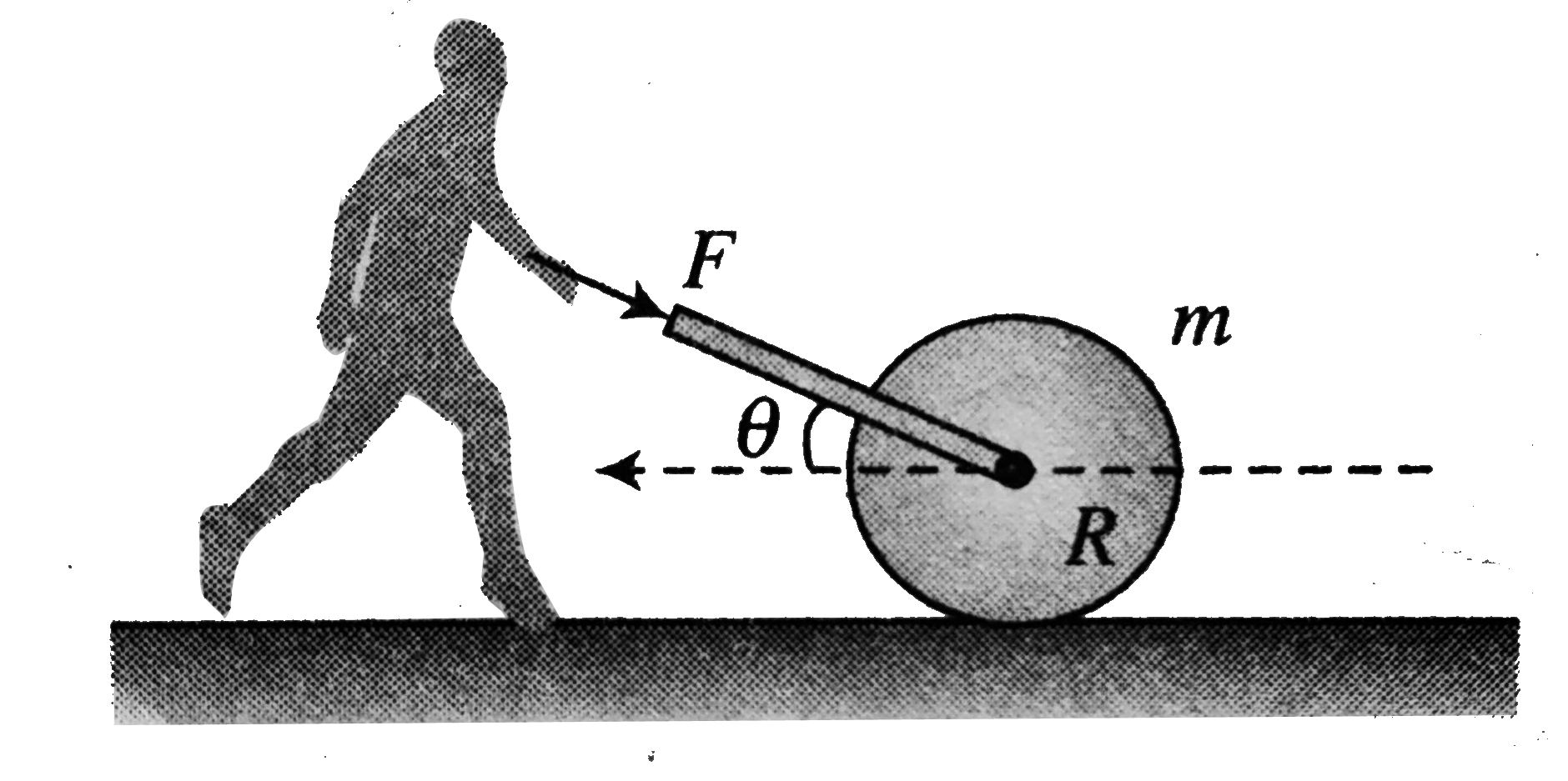
Maximum force F for no relative slidng if th coeficient of friction between the roller and ground is `mu`06:11View SolutionTwo wheels `A` and `C` are connected by a belt `B` as shown in figure. The radius of `C` is three times the raedius of `A`. What would be the ratio of the rotational inertias `(I_(A)//I_(C))` if both the wheels have the same rotational kinetic energy?
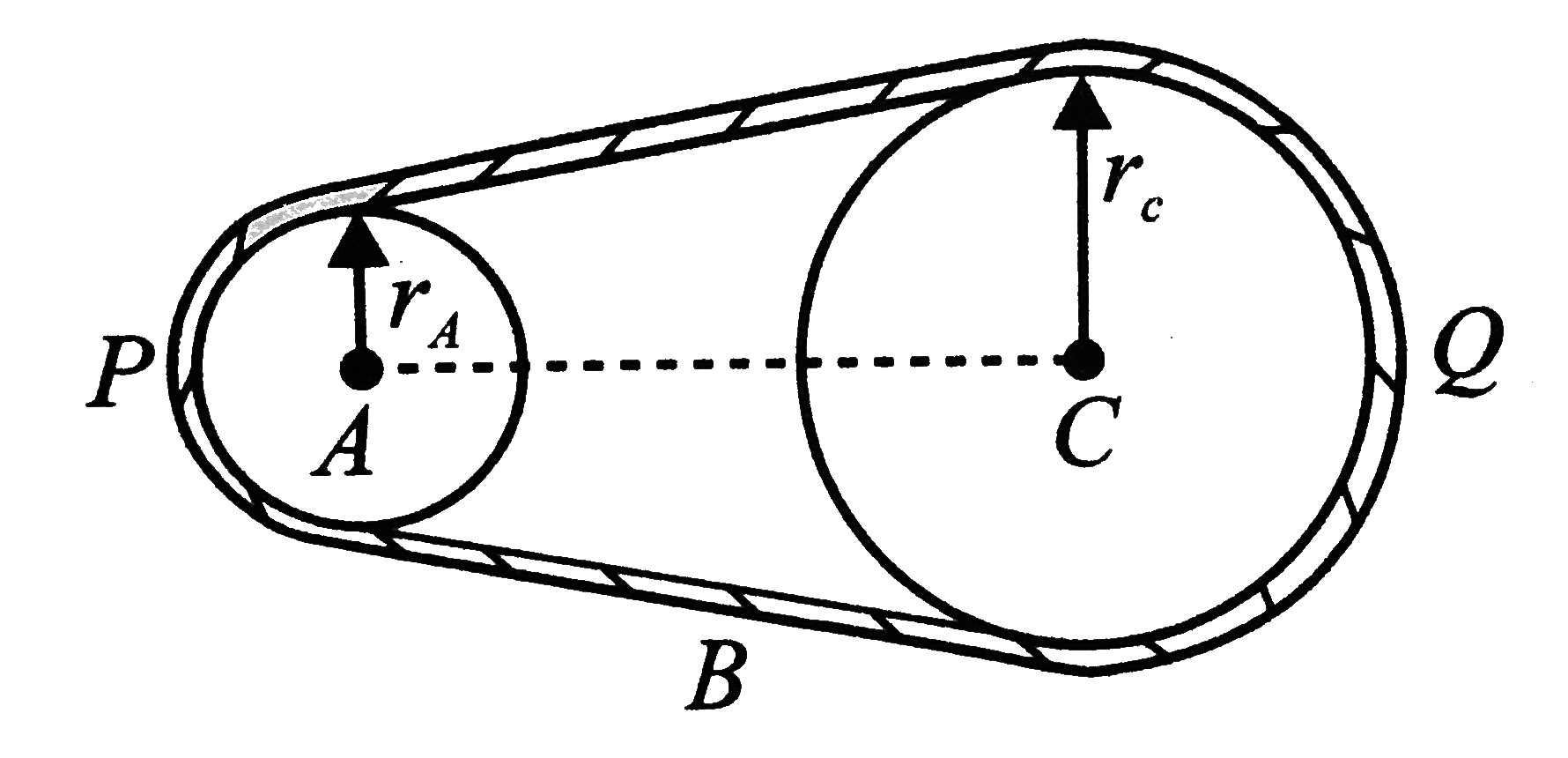 03:07View Solution
03:07View SolutionA solid ball of mass `m` and radius `r` spinning with angular velocity `omega` falls on a horizontal slab of mass `M` with rough upper surface (coefficient of friction `mu`) and smooth lower surface. Immediately after collision the normal component of velocity of the ball remains half of its value just before collision and it stops spinning. Find the velocity of the sphere in horizontal direction immediately after the impact (given: `Romega= 5`).
 03:34View Solution
03:34View Solution
System is shown in the figure. Velocity of sphere A is 9 `(m)/(s)`. Find the speed of sphere B.05:11View SolutionTwo forces of magnitude `F` are acting on a uniform disc kept on a horizontal rough surface as shown in the figure. Friction force by the horizontal surface on the disc is `nF`. Find the value of `n`.
 04:32View Solution
04:32View SolutionA disc of radius `R` is rolling purely on a flat horizontal, with a Constant angular velocity. The angle between the of velocity and acceleration vectors point `P` is given by `sin^(-1) (sqrt2//n)`. What is the value of `n`?
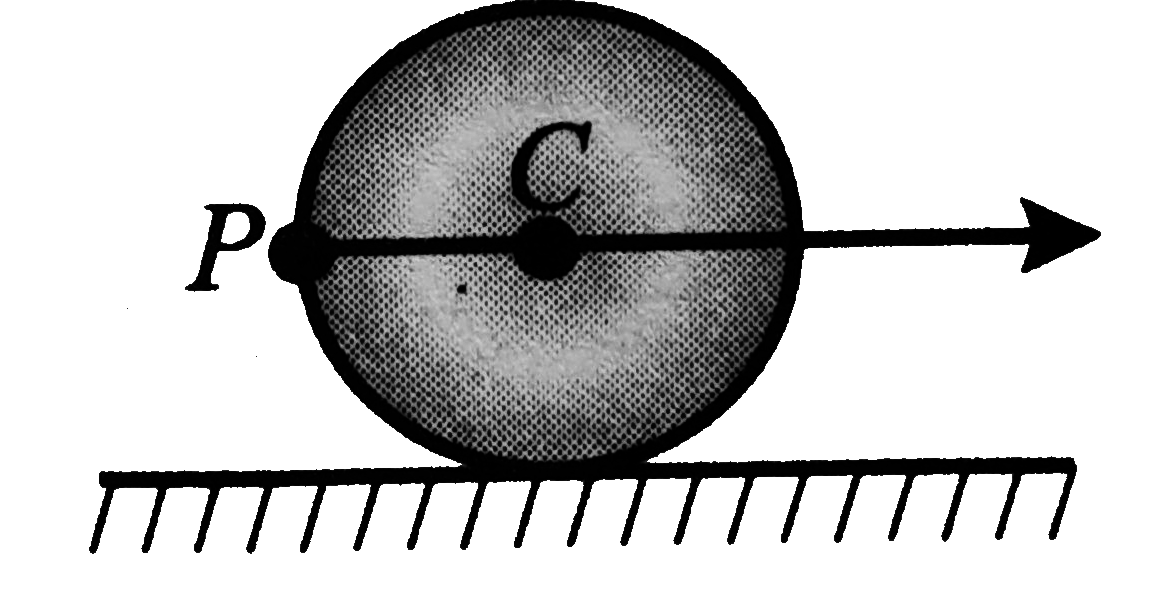 01:26View Solution
01:26View SolutionA boy is pushing a ring of mass 2 kg and radius 0.5 m with a stick as shown in the figure. The stick applies a force of 2 N on the ring and rolls it without slipping with an acceleration of `0.3 m//s^(2)`. The coeffecient of friction between the ground and the ring is large enough that rolling always occur and the coefficient of friction between the stick and the ring
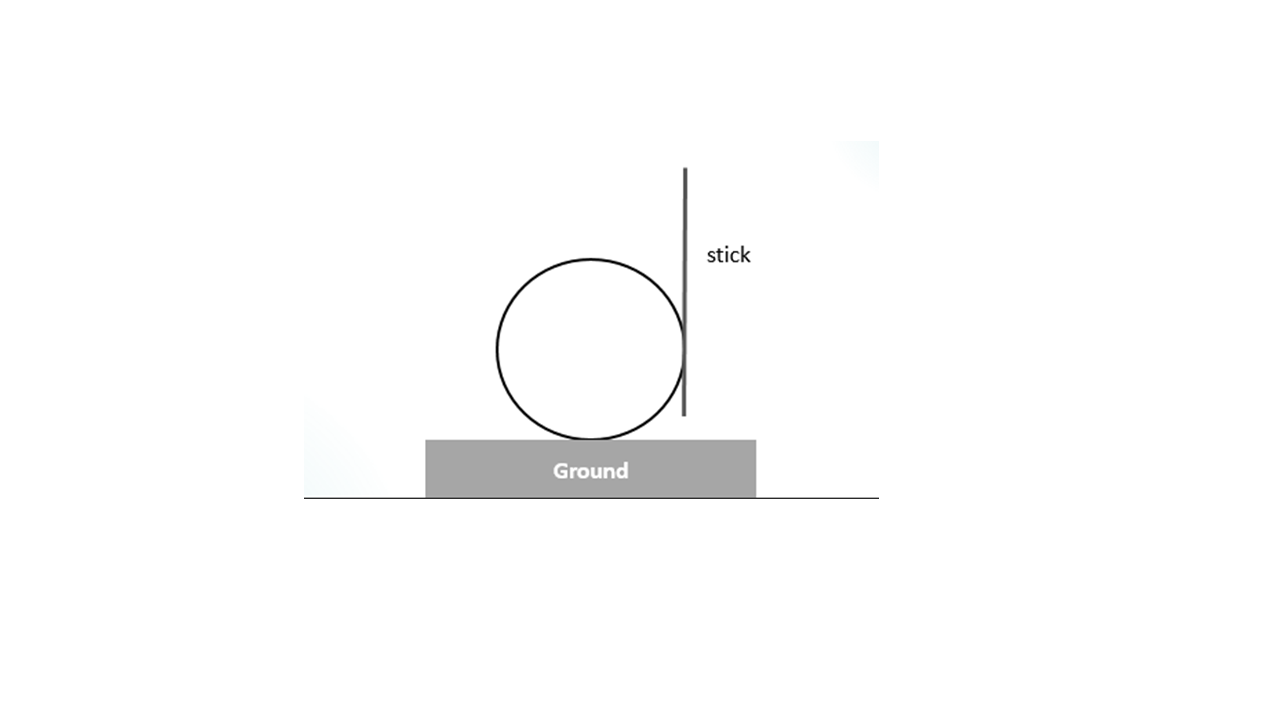 04:53View Solution
04:53View SolutionA parabolic wire as shown in the figure is located in x-y plane and carries a current l=10 amp. A unifrom magnetic field of intensity `2sqrt(2T),` making an angle of `45^(@)` with x-axis exists throughout the plane. If the coordinates of end point 'P' of wire are `(2m, 1.5 m)` then the total force acting on the wire is:
 05:23View Solution
05:23View SolutionWe apply a force of `10N` on a cord wrapped around a cylinder of mass `2kg`. The cylinder rolls without slipping on the floor. What is the kinetic energy (in joule) when cylinder has moved by a distance of `3//5` m?
 01:54View Solution
01:54View Solution
Linked Comprehension questions and complete solutions for chapter RIGID BODY DYNAMICS 2 of CENGAGE PHYSICS (ENGLISH) of Class 11
